Thai Creative Industries In Flux

The United Nations Conference on Trade and Development (2010), which has been instrumental in promoting and analysing creative economies all over the world through its Creative Economy Program, described the creative economy (CE) as “an evolving concept based on creative assets potentially generating economic growth and development.”
In Thailand, this concept has been proposed since the early 2000s as an engine of growth that could strengthen its international competitiveness. Almost two decades have passed, and Thailand still struggles to contextualise this concept in the Thai setting, manage the tension between economic and cultural values, and develop policies that recognise all stakeholders and allow them to contribute to sustainable development. For a country rich in culture and creative assets but stuck in the middle-income trap, there is no question that CE would bring a host of benefits to Thailand and its people. There have been many attempts to boost the economy through activities based on creativity and innovation, but the successful implementation of CE theories and practices is far from being realised.
Government Initiatives and Policies Related to the Creative Economy and Creative Industries
In Thailand, the concept of creative economy was first discussed when Thaksin Shinawatra was the Prime Minister of Thailand and developed during the premierships of Abhisit Vejjajiva and Yingluck Shinawatra. In 2009, the Thai government’s “Creative Thailand Policy” was initiated with an aim to make Thailand the creative industrial hub of ASEAN. Several government agencies, such as the Software Industry Promotion Agency (SIPA) (which became the Digital Economy Promotion Agency or DEPA in 2017), the Office of Knowledge Management and Development (OKMD), and Thailand Creative and Design Center (TCDC), were the key actors in advancing the idea of the CE in Thailand at the time. However, when a military coup took place in May 2014, all projects related to the creative economy were subsequently suspended. The focus of the National Council for Peace and Order (NCPO), the military junta which governed Thailand until July 2019, has been on the promotion of a digital economy, which could be seen as a way for the new government to distinguish itself from the policies created by earlier governments.
The focus on creative industries reappeared when the Creative Economy Agency (CEA) was reestablished in August 2018 by the Office of the Prime Minister, under the leadership of Prayuth Chan-O-Cha. The CEA aims to drive the creative economy policy forward through collaboration with public and private sectors. The first CEA Forum was held one year later to serve as a platform for knowledge and experience exchange regarding the development of the creative economy, including the creative economy policymaking, the formation of creative spaces for businesses and communities, and the utilisation of creativity as a means to gain a competitive advantage (CEA, 2019). In the past two and a half years, CEA has successfully initiated the Thailand Creative District Network (TCDN), which connects public authorities, the private sector, and civil society to develop creative spaces in municipalities all over Thailand.
The CEA was also active in providing research and information to the city authorities of Bangkok and Sukhothai in the application of UNESCO Creative Cities. In 2019, the two cities were designated “Creative City of Design” and “Creative City of Crafts and Folk Art,” respectively. CEA’s Bangkok Design Week, considered a growth engine for the creative industries, has been organised annually since 2018 and draws approximately 400,000 visitors each time. Moreover, there are a variety of smaller projects throughout the year, such as “CEA Online Academy,” an open online learning platform with creative skills courses, and “CEA Vaccine,” in which CEA commissioned over 300 artists and provided consultation and assistance to small and medium businesses in the creative industries (CEA, 2021).
Key Actors in Thailand’s Creative Economy
The Office of the National Economic and Social Development Council (NESDC) is responsible for policy development and is one of the key actors at a strategic level in the development of the creative economy and the creative industries. Figure 1 below shows all of the major players and their roles in the current landscape of the creative economy and the creative industries in Thailand. This list is not exhaustive and only includes some of the most prominent agencies whose work is directly related to the creative economy and the creative industries.
Challenges Faced by Thailand’s Creative Industries
In the 11th National Economic and Social Development Plan (2012-2016), NESDC identified four major groups and 15 industries within the creative economy, following UNCTAD’s classification. The groups were renamed, and their industries reshuffled in 2020 as follows:
i. Creative originals: Thai crafts, music, performing arts, and visual arts
ii. Creative content/media: Film and video, broadcasting, publishing, and software
iii. Creative services: Advertising, design, and architecture
iv. Creative goods/products: The fashion industry
v. Related industries: Thai food, traditional medicine, and cultural tourism (CEA, 2021)
According to CEA, the creative industries contributed 8.93 per cent to Thailand’s GDP in 2018 (0.8 per cent less than in 2015 at 9.1 per cent of GDP and 3.07 per cent less than in 2009 at 12 per cent of GDP). This contribution is valued at 46.4 billion US dollars. Figure 2 indicates the economic contribution of specific industries. In terms of growth, the only industry with an increase in its contribution to the country’s economy between 2016 and 2018 is visual arts (CEA Creative Economy Review, 2021).

The value of creative goods exports has been decreasing since 2018, and the COVID-19 pandemic has accelerated this trend. As a result, in the first half of 2020, exports of creative goods were down to 3.28 billion US dollars, 1.16 billion USD less than an equivalent period in 2019 (CEA Creative Economy Review, 2021).
In 2017, 826,026 individuals were classified as creative workers in Thailand, representing around 1.5 per cent of the total labour force. Of the total, 300,829 or 36 per cent are in the craft industry. The creative workforce has been shrinking since 2016, particularly in the Thai crafts and design sectors. This is due to a decrease in interest among younger generations, changing demand for craft commodities produced for global markets, and increasing costs of production compared to other countries in the world market (CEA Creative Economy Review, 2021; Chudasri, Walker, and Evans, 2012). The number of craftspeople represented in the surveys may not fully reflect the reality of the craft sector, however. In a paper presented at the 18th International Conference on Cultural Economics, Simon Ellis (2014) asserts that due to the nature of craft production, the creativity of local artisans in rural communities is often overlooked in models derived from Europe and other fully-developed economies that focus on employment or entrepreneurship (when these artisans fit the definition of an entrepreneur).
The decline of the creative industries’ contribution to Thailand’s economy is caused by a combination of these factors:
i. Political instability and discontinuity in policy implementation: While creative economy and creative industriesrelated policies have been discussed since 2009, military coups and ongoing political turmoil have prevented effective implementation. Both the 20-year National Strategy and the 12th National Economic and Social Development Plan currently in effect emphasise the digital economy rather than the creative economy, which was the focus of 11th Plan, disrupting policy implementation. The establishment of the CEA in 2018 led to concrete outcomes, generating public-private partnerships in support of the creative economy in Thailand in recent years. The political climate is still unpredictable, however, and any shift in the government’s strategy could affect the continuity of ongoing funding and projects.
ii. The lack of understanding of the cultural and the creative industries: In Thailand, culture is commonly thought of as being connected to national identity and tradition, collectively seen as “the past.” Creativity, on the other hand, is associated with new ideas that can drive society into the future. High-ranking officials view culture as something to be preserved and protected, not needing “creativity”. This could be why the creative industries group title “cultural heritage” adopted from UNCTAD’s classification was later changed to “creative originals.”
Cultural tourism, however, is still present in the latest classification. But this is problematic. Cultural tourism refers to “travel concerned with experiencing cultural environments, including landscapes, the visual and performing arts, and special (local) lifestyles, values, traditions, events as well as other ways of creative and inter-cultural exchange processes” (UNESCO, 2004). Based on this definition, all types of tourism present in Thailand can be regarded as cultural tourism. It is important to point out that cultural tourism and Thai food account for 46 per cent of the creative industries (in 2018) even though they are both considered “related industries.” Therefore, including their economic value in the analysis can give a false impression of the economic contribution of the creative industries to Thailand’s GDP. A recent study by UNESCO shows that the contribution of cultural and creative industry sectors to national GDP in Thailand cannot be accurately measured due to a lack of reliable data (UNESCO, 2021).
iii. New media and the changing digital landscape: The revolution in digital technology is changing the way Thai people live. It was reported that over 75 per cent of Thailand’s population use the internet, 16 per cent more than the global average. Thais’ average daily internet usage is nine hours, ranking fifth globally; the world average is six hours and 43 minutes (Nation, 2020). This phenomenon has opened up more opportunities for the creative industries, especially in the software industry. The coronavirus pandemic has accelerated the adoption of digital platforms and ways of working, but not all industries have seen the benefits of the increased reach. The entertainment industry, for example, has been forced to find alternative income streams and production has been heavily impacted. Independent studios and smaller productions have found paths to distribution via new or established streaming services in place of full-scale theatre releases. With any disruption of this magnitude, there are opportunities, but also risks and challenges; creative workers and organisations in the fields of performing arts, film, and broadcasting must adapt to the changing landscape (Ramasoota and Kitikamdhorn, 2021).
Paths Forward
To encourage creative industries to grow, strengthen Thailand’s creative economy, and achieve sustainable development in the long term, steps must be taken to address the challenges.
First, we need to strengthen long-term strategy and provide consistent funding opportunities for creative workers and organisations. The decline of the creative industries’ contribution to Thailand’s GDP correlates with the focus shift from the creative economy to the digital economy. The digital economy is favoured for the belief that it could lead to more concrete products and services in the short term. It is crucial to remember that the creative economy may take longer to implement and see visible results, but its impacts extend beyond the creative industries and their economic value. The creative economy, once it reaches its maturity, will keep cultural significance alive. It will connect people of diverse backgrounds and brings about unity in society.
Moreover, the creative economy is closely related to the digital economy as well. Innovative technology can enhance and add value to the creative industries, and the digital industries can greatly benefit from the creativity embedded in culture and tradition. Only when the creative economy’s potential is fully recognised in government strategy and policies, and funding is provided for the creative industries to improve the processes of cultural and creative productions will we begin to see its sustainable economic and social impacts.
Second, we must develop reliable methods of measuring the true contribution of the creative industries to GDP. Because the creative economy is based on creativity, culture, and knowledge, it is unique to each location. The classifications and models provided by international organisations like UNCTAD need to be adapted to fit the conditions of Thailand. As mentioned earlier, the method of data collection and the criteria used to determine the contributions that are derived from other developed countries are not necessarily suitable for Thailand. In addition, there has to be agreement on what activities should be included in the creative industries. We cannot deny the immense contribution of cultural tourism to Thailand’s economy, but it is difficult to classify tourism in Thailand as “cultural” or not. The same thinking can be applied to Thai food and traditional medicine, which are considered related industries. Related industries have always been included in national statistics, skewing the contribution of the creative economy to appear much larger in scale than if they were excluded. In order for creative industries to be adequately developed and to reach their potential, this distinction is important. An understanding of their real contribution needs to be reached to make the right strategic decisions and offer the right support.
Third, we must facilitate the development of skills to allow artists and creative/ culture workers to keep up with the global advancement of technology. Even with the high growth rate of the software industry in recent years, there is still a lack of specialists and skilled labour available (DEPA, 2021). Without the knowledge and tools necessary, creative workers cannot keep up with digital disruption and transformation. Just as the nature of the creative economy is different in each country, skill-development programmes should be contextual and in consonance with the existing environment. Collaboration is key to creativity and learning; thus, knowledge and experience sharing is encouraged. For the creative economy to be sustainable, a creative education needs to be implemented nationwide. This will allow children to express their creativity and develop their creative potential to benefit society at large.
Finally, we must strengthen local governance and community participation in the creative industries programmes. Jane Jacobs (1961, 238), an American social activist and urban planning pioneer, observes “cities have the capability of providing something for everybody, only because, and only when, they are created by everybody.” The long-standing success of the Creative Chiangmai Initiative can be attributed to its development committee that consists of a wide range of stakeholders, including those from education, government agencies, companies, and local communities (Creative Chiangmai, 2020). The development of the creative economy cannot be sustainable if it is led by government policy alone. Everyone’s opinion in each community has to be heard and considered. All of the projects implemented should welcome people from all sectors and all generations to participate and benefit from. It is only when everyone feels included that a creative economy can grow organically.


Amazing Thailand Launches “Your Stories Never End” Campaign at Arabian Travel Market 2024
Along with strong thai delegation, comprising a contingent of 64 exhibitors..
Dubai, 7 May 2024 – The Tourism Authority of Thailand (TAT) has launched the latest communication concept, “Amazing Thailand: Your Stories Never End,” at the Arabian Travel Market (ATM), where the Thai pavilion presents a contingent of 64 Thai exhibitors at Dubai World Trade Center, United Arab Emirates, from 6-9 May 2024.
Ms. Thapanee Kiatphaibool, TAT Governor, said , “This is Thailand’s 24th year of participation in the Arabian Travel Market. This year also marks the first time that TAT and the Phuket Tourist Association have strengthened cooperation in presenting exhibitors from Phuket in a dedicated zone under the umbrella of the Thai pavilion.”
The Thai contingent includes 36 exhibitors from Phuket, 22 from Bangkok, three from Krabi, two from Chon Buri (Pattaya) and one from Surat Thani (Ko Samui). These constitute 40 hotels, 11 destination management companies, three wellness and medical service institutes, eight attractions and theme parks, and the Thailand Privilege Card.
At the Thai pavilion, Phuket exhibitors are presented in a dedicated zone with 26 tables, while the rest occupy 36 other tables in the main zone and the Thailand Privilege Card exhibits in a private area. The main entrance boasts a demonstration area of distinctive Thai soft power and a Thai tourism information counter with English and Arabic speaking officers.
Mr. Siripakorn Cheawsamoot, TAT Deputy Governor for International Marketing – Europe, Africa, the Middle East, said “Thailand’s presence this year has been strengthened with a very good mix of exhibitors that cater to different customer bases of the Middle East market, especially the established family market and the growing shopping and luxury segments. The strong presence of Phuket underpins its commitment to boost the destinations’ profile as a destination for visitors from the Middle East.”
During the ATM 2024, TAT has scheduled a signing of a strategic partnership agreement with dnata Travel. It has also planned meet-and-greet sessions with Emirates Airlines, WEGO and Qatar Airways, as well as interviews with local media.
TAT also leverages its participation at ATM 2024 with the launch of the new communication concept, Amazing Thailand: Your Stories Never End , held on 6 May for tour operators, airlines, local media and influencers.
Mr. Nithee Seeprae, TAT Deputy Governor for Marketing Communications, said “This concept encapsulates our commitment to creating unforgettable experiences for every traveller who visits our beloved kingdom. We aim to instil lasting memories and meaningful journeys that will inspire visitors to become storytellers, sharing their own unique tales of Thailand with others around the world.”
To encourage travellers to create never-ending stories in Thailand, TAT will continue to promote the kingdom’s 5F soft-power foundations – Food, Film, Festival, Fight and Fashion – to add value to tourism products and services as well as offer meaningful experiences to travellers.
Some of the highlight experiences travellers can enjoy while in Thailand include wellness, hidden-gem cities, and world-class events.
In 2023, Thailand welcomed 28 million visitors, generating a revenue of 1.2 trillion Baht. Of these, 651,049 visitors from the Middle East, a 28% increase compared to the pre-COVID year of 2019.
For 2024, TAT has set a target of generating 3 trillion Baht, with 1.92 trillion Baht coming from international tourism and 1.08 trillion Baht from domestic tourism. These include over 1.11 million travellers from the Middle East and more than 106 billion Baht revenue.
Photo Gallery 1: The Thai pavilion was officially opened by Ms. Thapanee together with Miss Nipa Nirannoot, Consul-General of Thailand to Dubai and the Northern Emirates. Also present at the event were executives and representatives from the Team Thailand in Dubai and the Northern Emirates, the TAT, tourism associations and the Thailand Privilege Card.

Photo Gallery 2: “Your Stories Never End” Media Launch 2024

TAT Newsroom
Tat and unionpay international sign letter of intent, related articles.

CF-Hotels Initiative Reiterates TAT’s Push Towards Sustainable Tourism


Passing Thru Travel
Discover Thailand: Your Ultimate Guide to 20 Incredible Destinations in 2024
Posted: March 5, 2024 | Last updated: March 5, 2024
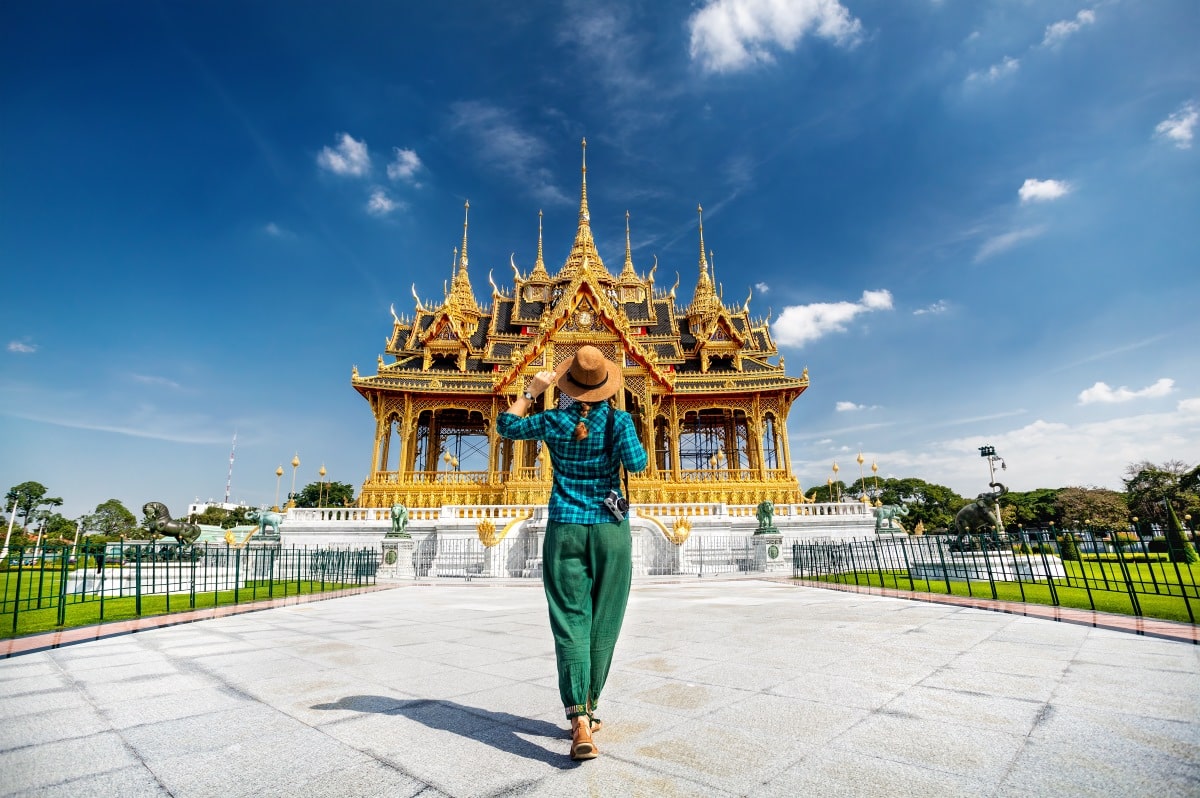
Thailand, with its rich cultural heritage, stunning landscapes, and renowned hospitality, offers a plethora of experiences for every traveler. From the bustling streets of Bangkok to the serene beaches of the south and the lush mountains of the north, this guide will take you through the diverse facets of Thailand, ensuring a journey filled with discovery and wonder.
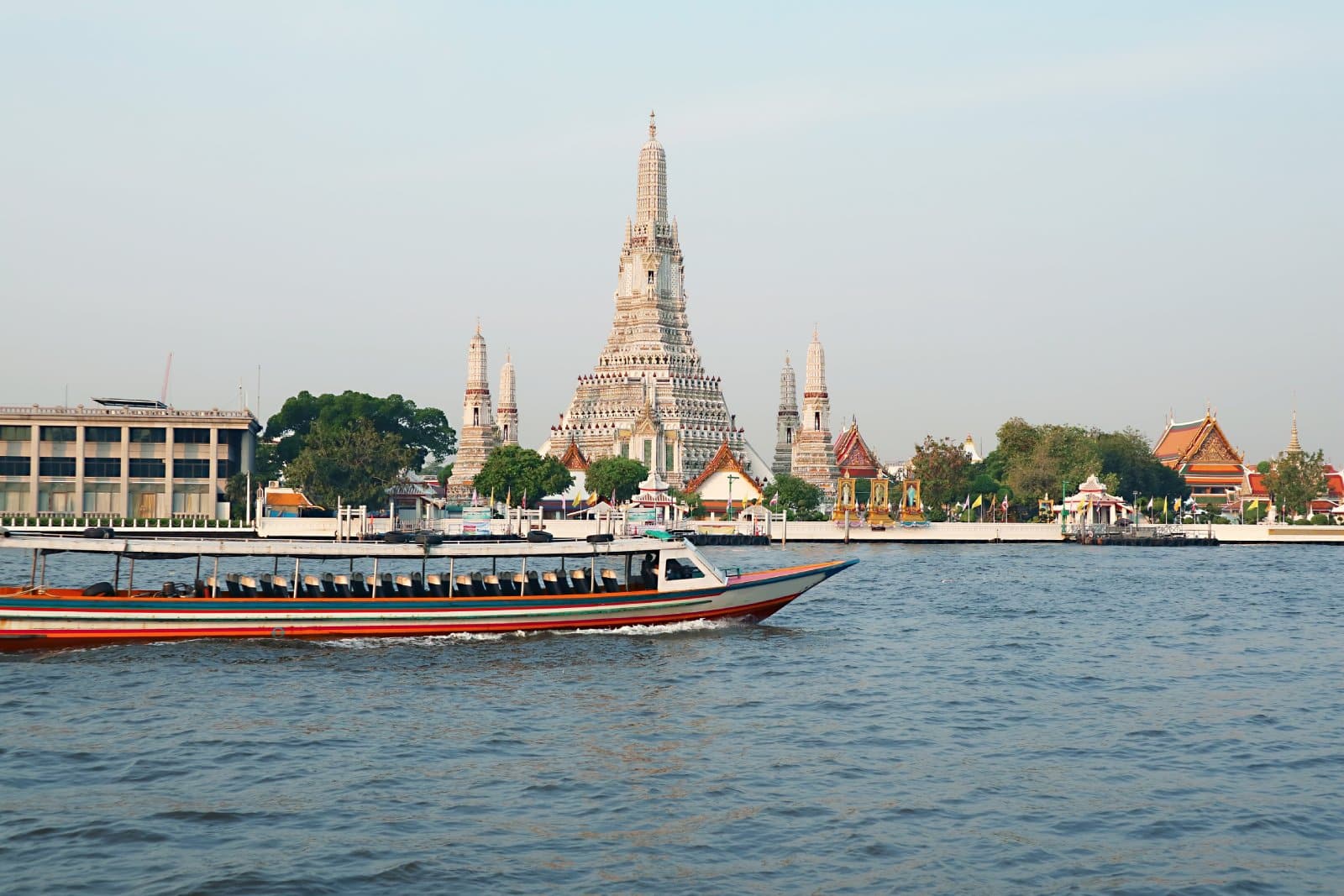
Bangkok, a city where ancient traditions seamlessly blend with modernity, offers an experience like no other. As you navigate its bustling streets, you’ll encounter magnificent temples such as Wat Phra Kaew and Wat Arun, standing as serene sanctuaries amidst the urban chaos. The Grand Palace, a former royal residence, highlights the city’s rich history and architectural grandeur.
For shopping enthusiasts, the sprawling Chatuchak Weekend Market presents a labyrinth of stalls selling everything from vintage clothing to local handicrafts. Don’t miss the opportunity to indulge in Bangkok’s renowned street food, where dishes like Pad Thai and Som Tam are served with authentic flavors.
The city’s vibrant nightlife, from rooftop bars to lively street markets, pulsates with energy, offering a glimpse into the contemporary lifestyle of Bangkok’s residents. Navigating Bangkok explores contrasts, where each turn presents a new facet of this dynamic city.
Insider’s Tip: Visit the lesser-known but equally impressive Wat Benchamabophit for a more tranquil temple experience.
How To Get There: Bangkok is accessible by its two main airports, Suvarnabhumi and Don Mueang. The city has an extensive public transport system, including the BTS Skytrain and MRT.
Best Time To Travel: The cool season from November to February is ideal, with pleasant weather and numerous festivals.

2. Chiang Mai
In Chiang Mai, the cultural heart of Northern Thailand, you’ll find a more laid-back atmosphere than Bangkok’s frenetic energy. The city is replete with historic temples, the most famous being Wat Phra Singh and Wat Chedi Luang, each offering a peaceful retreat and a look into the spiritual practices of the locals. The Night Bazaar and Sunday Walking Street Market are hubs for artisanal crafts and street food, reflecting the city’s artistic flair and culinary richness.
Just outside the city, the lush landscapes of Doi Inthanon National Park await, with trekking trails leading to waterfalls and hill tribe villages. Chiang Mai’s charm lies in its blend of history, culture, and nature, providing a holistic experience of Thailand’s northern region.
Whether you’re exploring its ancient temples, engaging in a traditional Thai cooking class, or wandering through its vibrant markets, Chiang Mai captivates with its serene beauty and rich cultural tapestry.
Insider’s Tip: Take a Thai cooking class to delve deeper into the region’s unique flavors.
How To Get There: Chiang Mai has an international airport and is also accessible by train or bus from Bangkok.
Best Time To Travel: Visit during the cool season, particularly in November, for the Yi Peng Lantern Festival.
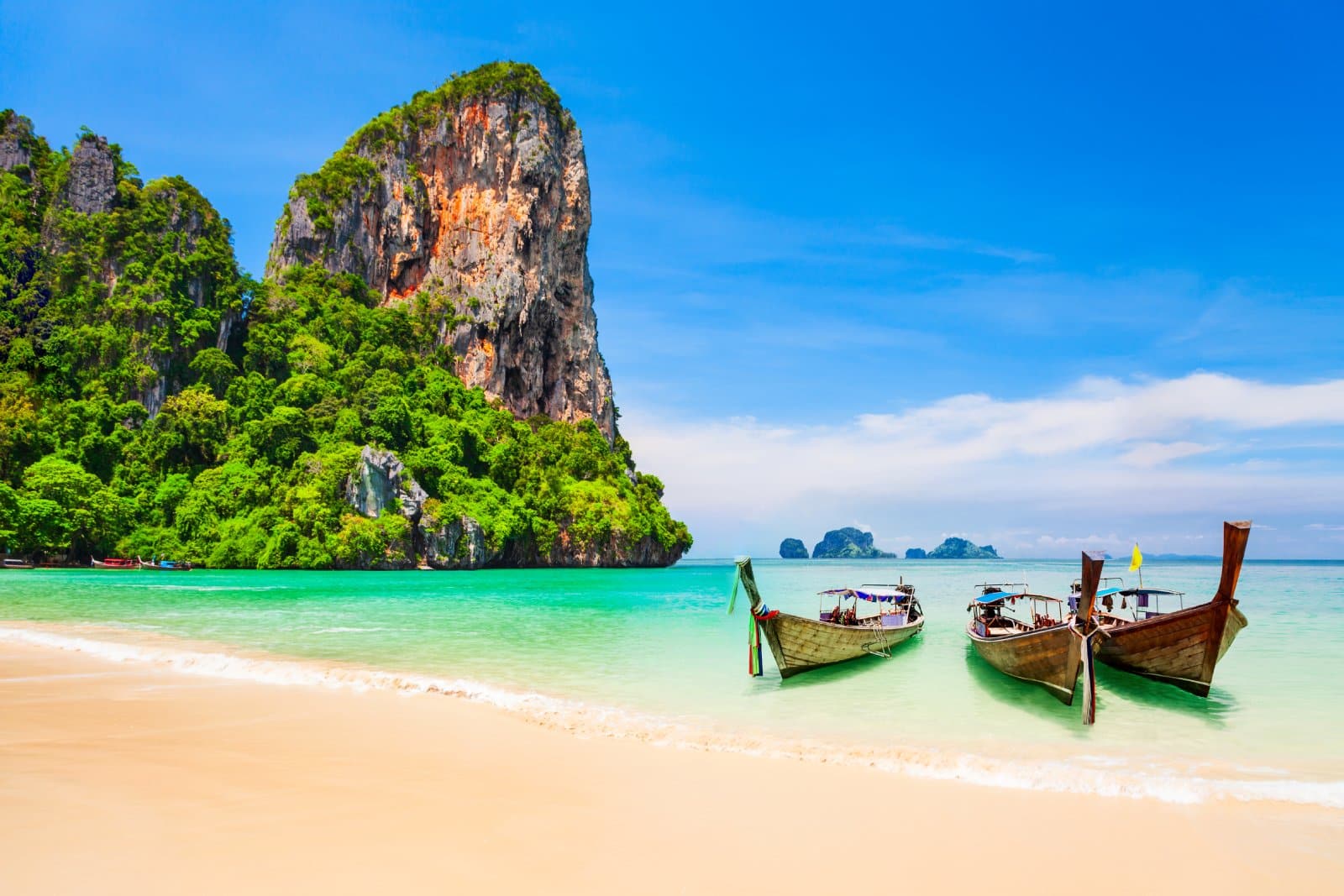
Phuket, Thailand’s largest island, is a blend of experiences catering to those seeking relaxation and adventure. The island’s beaches, like Patong, Kata, and Karon, offer a range of atmospheres, from bustling shores with water sports activities to more tranquil retreats. Beyond its stunning beaches, Phuket’s Old Town reveals a different side of the island, with Sino-Portuguese architecture and a burgeoning arts scene.
A visit to the Big Buddha is a must for a panoramic view of the island. The surrounding waters of Phuket, particularly the Phi Phi Islands and Similan Islands, are a paradise for divers and snorkelers, boasting vibrant marine life and crystal-clear waters.
Phuket’s nightlife, especially in Patong, pulsates with energy, offering many entertainment options. The island’s diversity, from its natural beauty to cultural richness, makes Phuket a microcosm of Thailand’s allure.
Insider’s Tip: Take a day trip to the Phi Phi Islands for some of the best snorkeling and diving.
How To Get There: Phuket is accessible by its international airport or by bus and ferry from the mainland.
Best Time To Travel: The best weather is from November to February, with calm seas and sunny skies.
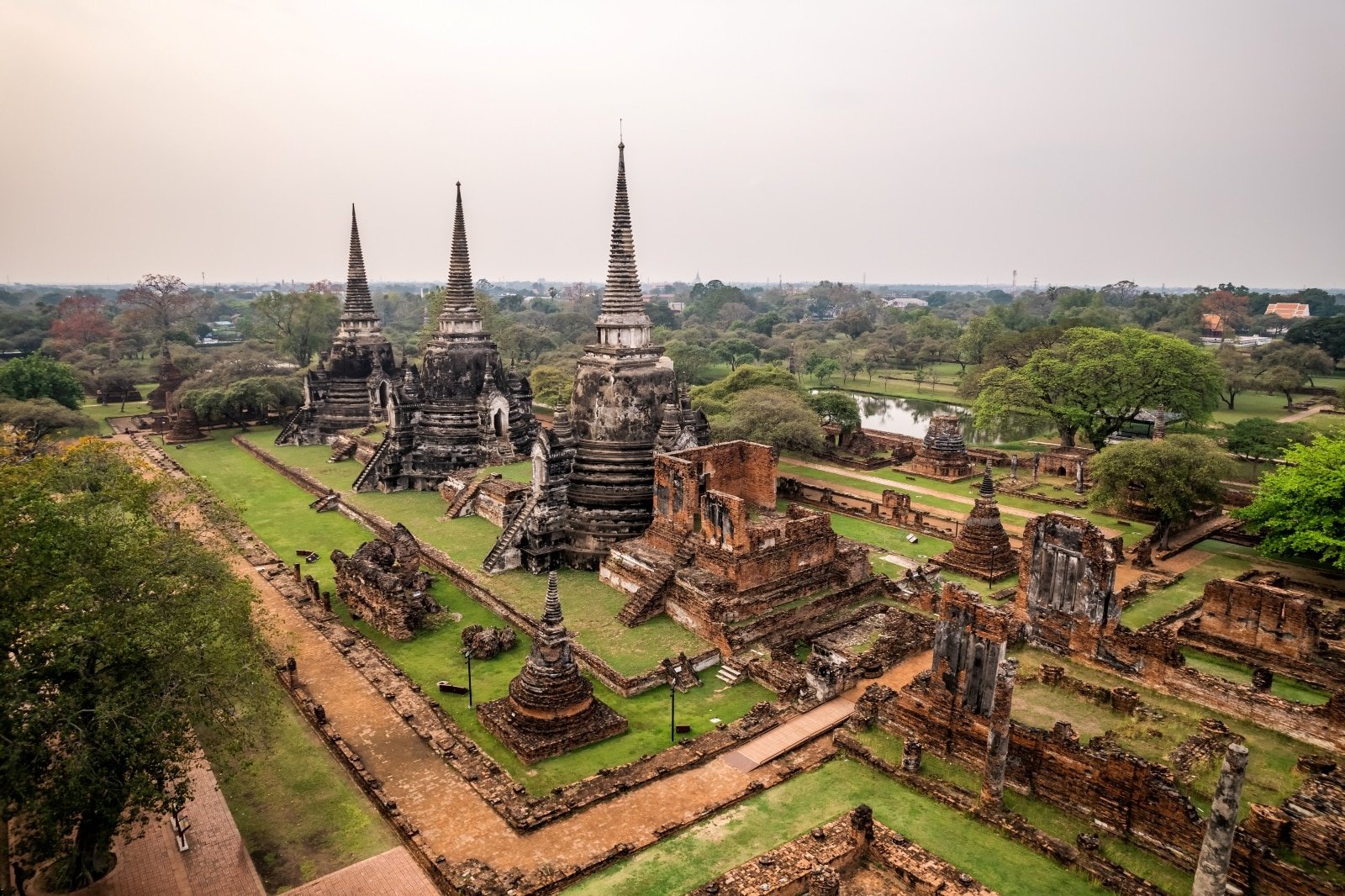
4. Ayutthaya
The ancient city of Ayutthaya, once the capital of the Kingdom of Siam, stands today as a UNESCO World Heritage Site, offering a journey through Thailand’s storied past. As you wander through the historical park, you’ll encounter the ruins of temples and palaces, each telling a tale of the city’s former glory and subsequent destruction.
The site’s most iconic structures, such as Wat Mahathat and Wat Phra Si Sanphet, showcase the sophisticated art and architecture of the Ayutthaya period. Exploring Ayutthaya is not just a historical excursion; it’s an immersive experience that transports you back to when the city was a major trading hub of Asia.
The juxtaposition of ancient ruins against a backdrop of modern life underscores the enduring legacy of Ayutthaya’s historical and cultural significance in Thailand.
Insider’s Tip: Visit during the early morning or late afternoon to avoid the heat and crowds.
How To Get There: Ayutthaya is a short train or bus ride from Bangkok.
Best Time To Travel: The cool season, from November to February, offers comfortable exploring conditions.
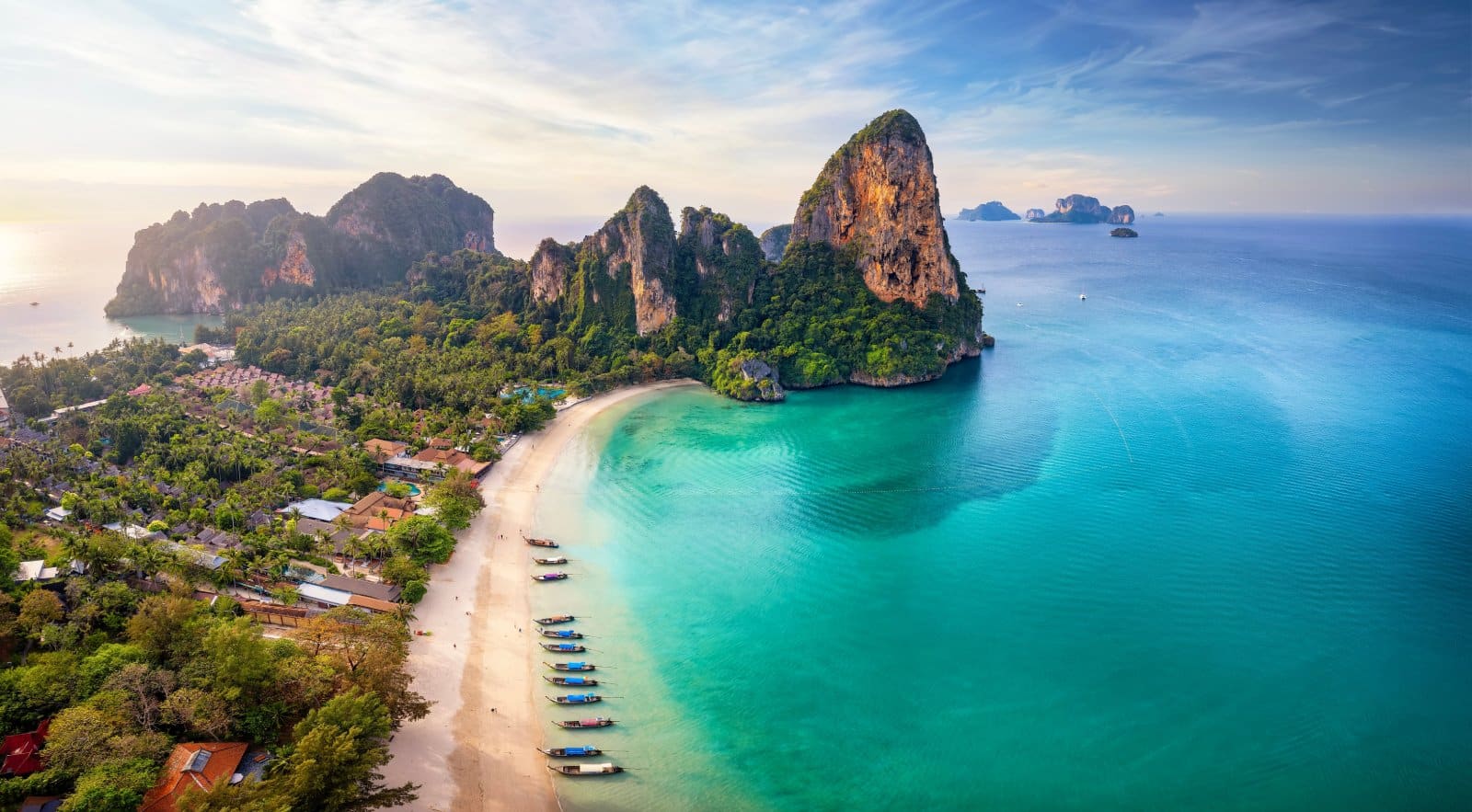
In Krabi Province, you’ll find yourself amidst some of Thailand’s most picturesque landscapes, marked by dramatic limestone cliffs, pristine beaches, and clear blue waters. The province is renowned for destinations like Railay Beach, which is accessible only by boat. It offers world-class rock climbing and stunning beachscapes.
The Phi Phi Islands, with their iconic beaches and vibrant marine life, are perfect for day trips, offering opportunities for snorkeling and diving. For a more tranquil experience, the lesser-known Koh Lanta provides a laid-back atmosphere with its long, sandy beaches. Krabi’s natural beauty extends beyond its coastline, with inland attractions like the Emerald Pool and the Tiger Cave Temple, each offering unique experiences.
Whether you’re seeking adventure on the cliffs of Railay or tranquility on the beaches of Koh Lanta, Krabi presents a diverse array of natural wonders waiting to be explored.
Insider’s Tip: Explore the mangroves and limestone caves by kayak for a unique perspective.
How To Get There: Krabi has an airport, and it’s also accessible by bus and boat from other parts of Thailand.
Best Time To Travel: Visit from November to March for the best beach weather.
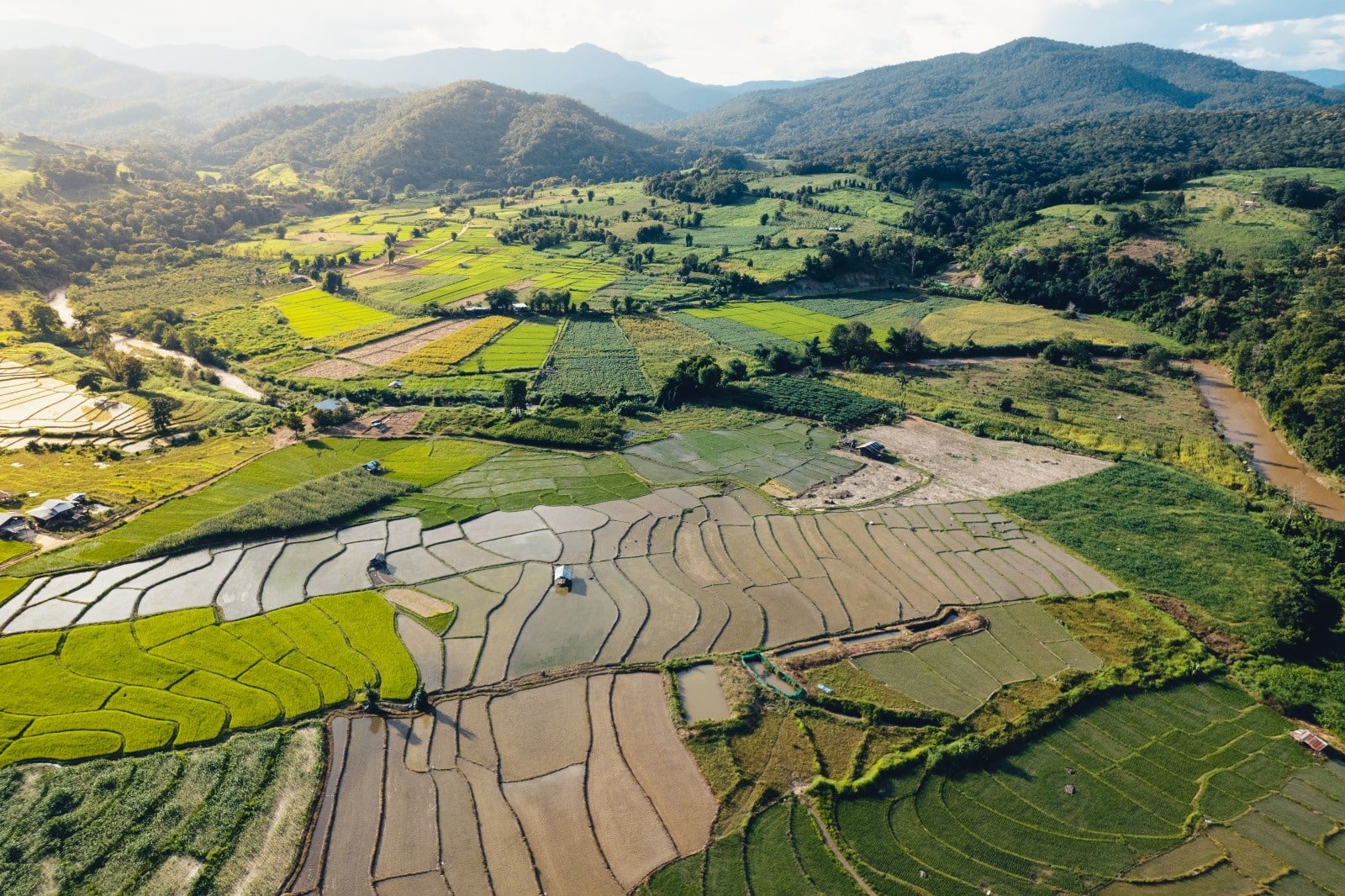
Pai, nestled in the mountains of Northern Thailand, is a haven for those seeking tranquility and natural beauty. With its relaxed atmosphere, this small town attracts travelers looking to escape the hustle of city life. Surrounded by rolling hills and lush greenery, Pai is perfect for outdoor activities like hiking, visiting waterfalls, and exploring hot springs.
The Pai Canyon offers stunning views, especially at sunset, and is a must-visit for nature enthusiasts. The town’s charming cafes, night markets, and art galleries reflect a unique blend of local Thai culture and bohemian influences.
Renting a scooter to explore the surrounding countryside is a popular way to discover the area’s hidden gems, but be cautious on the winding roads. Pai’s natural beauty, laid-back vibe, and cultural richness make it a refreshing stop in your Thailand journey.
Insider’s Tip: Rent a scooter to explore the surrounding countryside, but be cautious on the winding roads.
How To Get There: Pai is accessible by bus from Chiang Mai.
Best Time To Travel: The cool season, particularly from October to February, is ideal for comfortable temperatures.
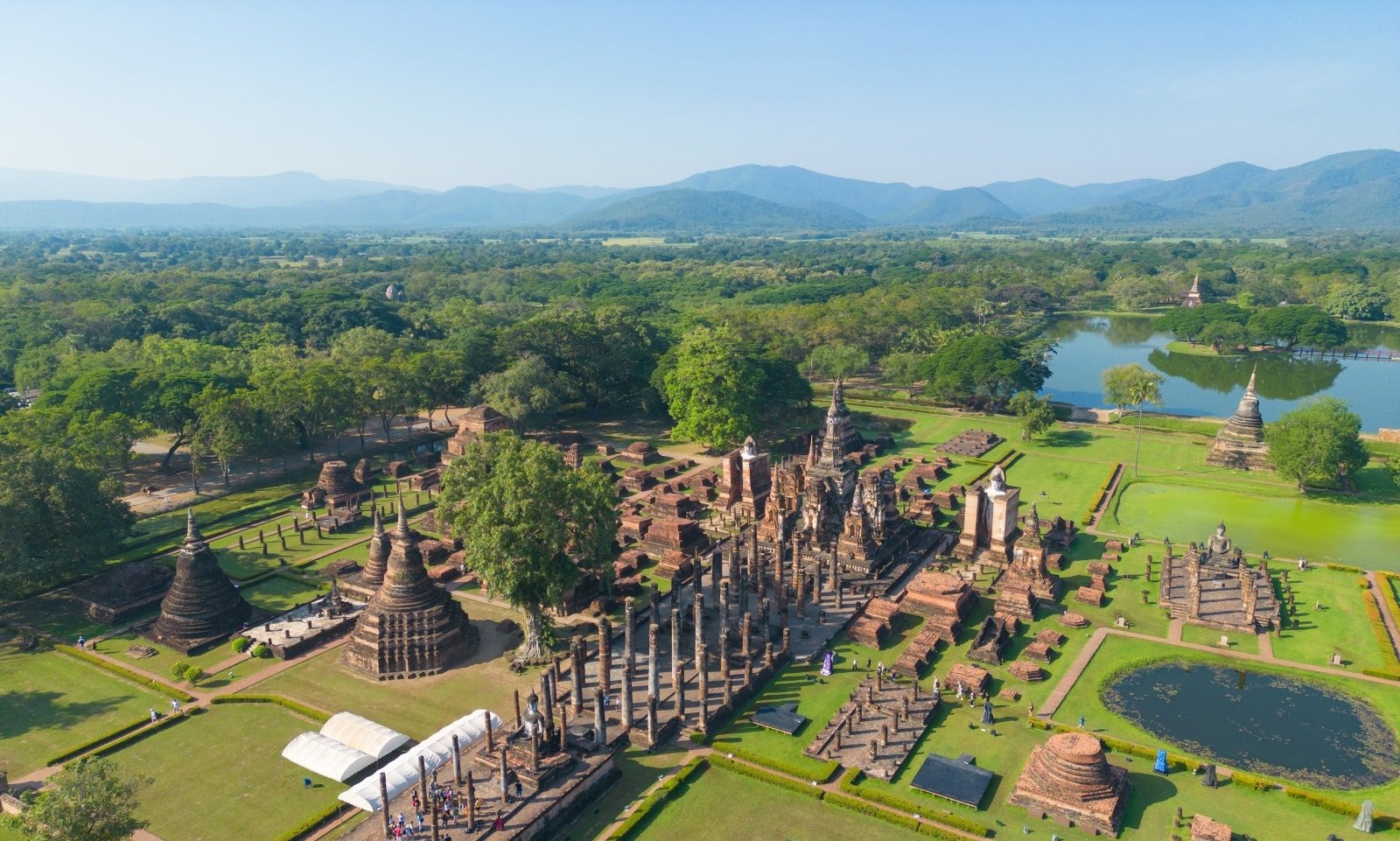
7. Sukhothai
Sukhothai, the first capital of Thailand, is where Thai art, architecture, and language began to develop and flourish. The Sukhothai Historical Park, a UNESCO World Heritage Site, is an archaeological delight with well-preserved ruins and majestic Buddha statues set amidst scenic lakes and gardens.
Exploring this ancient city on a bicycle offers a leisurely and intimate experience of the park’s vast grounds. Highlights include Wat Mahathat, with its impressive central stupa, and Wat Si Chum, known for its gigantic seated Buddha.
The historical significance of Sukhothai, coupled with its serene and picturesque setting, provides a profound insight into the origins of Thai culture and the nation’s early history.
Insider’s Tip: Visit during the Loy Krathong festival in November, when the park is beautifully lit with lanterns.
How To Get There: Sukhothai is accessible by bus or plane from Bangkok and Chiang Mai.
Best Time To Travel: The cool season is the best time to visit, especially around the Loy Krathong festival.
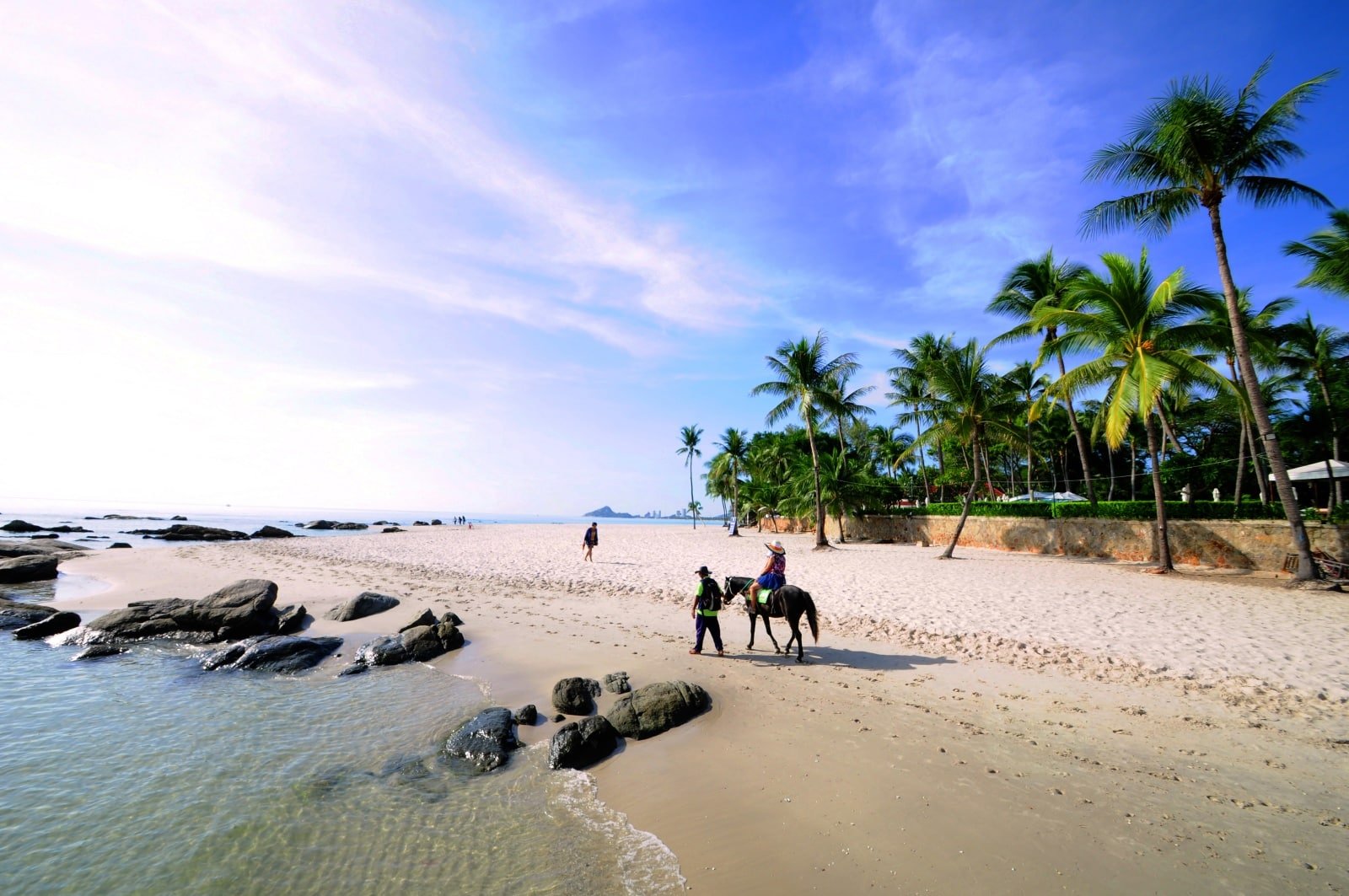
Hua Hin, once a quiet fishing village and now a popular beach resort town, offers a perfect blend of relaxation and cultural experiences. Known for its beautiful beaches, golf courses, and the summer palace of the Thai royal family, Hua Hin exudes an air of sophistication and tranquility.
The night markets in Hua Hin, particularly the Cicada Market, are great for experiencing local crafts and cuisine. Nearby natural attractions like Sam Roi Yot National Park, with its limestone mountains and mangrove forests, provide opportunities for nature exploration.
Hua Hin’s combination of beachside leisure, royal heritage, and natural beauty makes it an ideal destination for those seeking a more laid-back experience in Thailand.
Insider’s Tip: Try the local seafood at the night market, known for its freshness and variety.
How To Get There: Hua Hin is about a three-hour drive from Bangkok and is also accessible by train.
Best Time To Travel: Visit from November to February for the best beach weather and fewer rain showers.
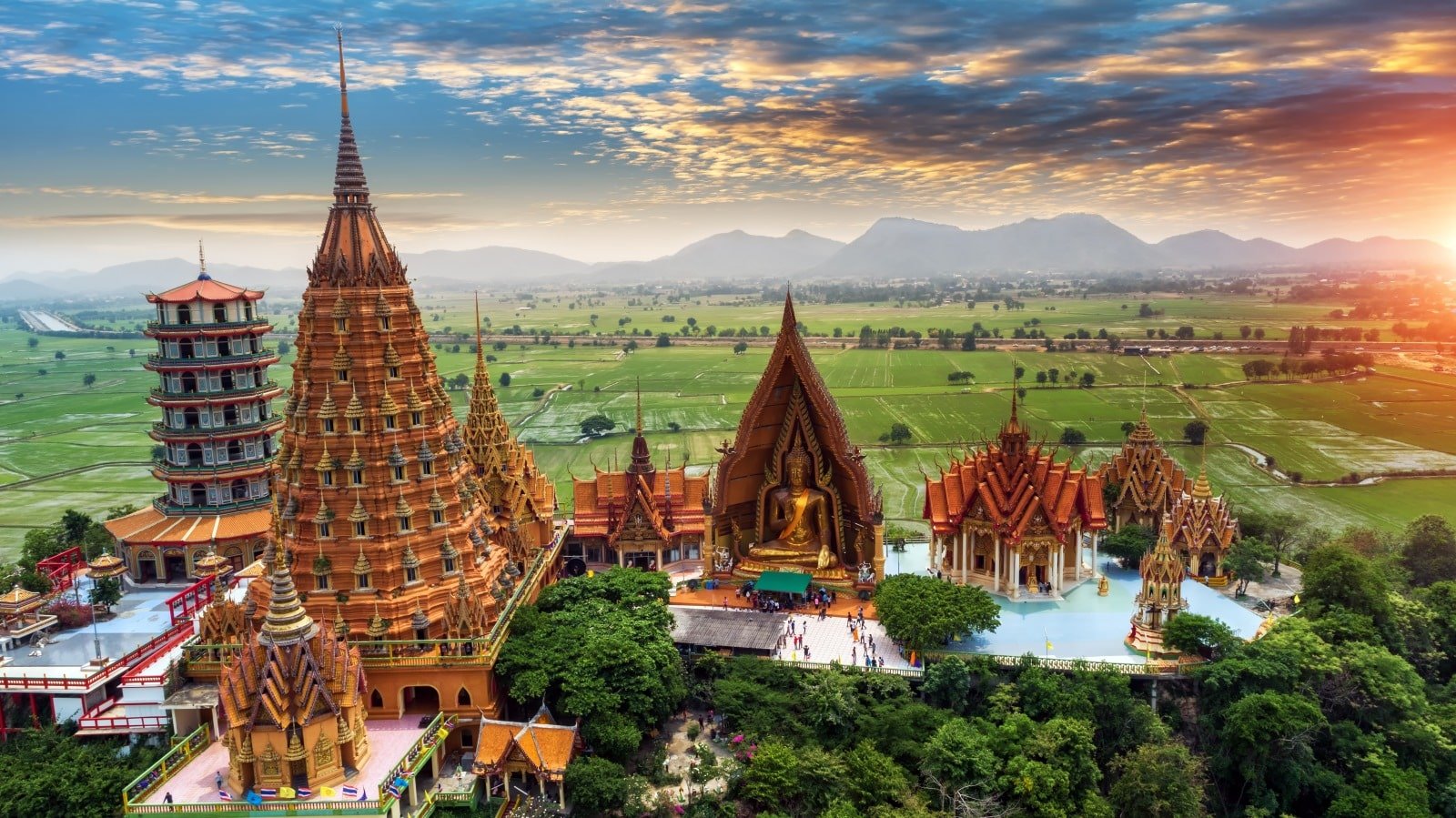
9. Kanchanaburi
Kanchanaburi, known for the Bridge over the River Kwai and its World War II history, offers a poignant reminder of the past, set against a backdrop of stunning natural scenery. The Death Railway, war cemeteries, and museums provide a deep understanding of the region’s wartime history.
Beyond its historical significance, Kanchanaburi is also home to beautiful national parks like Erawan and Sai Yok, offering trekking, waterfalls, and river rafting. The province’s blend of history and natural beauty provides a multifaceted experience, making it a destination that appeals to history buffs and nature lovers.
Insider’s Tip: Take a train ride on the Death Railway for a scenic and historical journey.
How To Get There: Kanchanaburi is accessible by bus or train from Bangkok.
Best Time To Travel: The cool and dry season from November to February is ideal for exploring and outdoor activities.
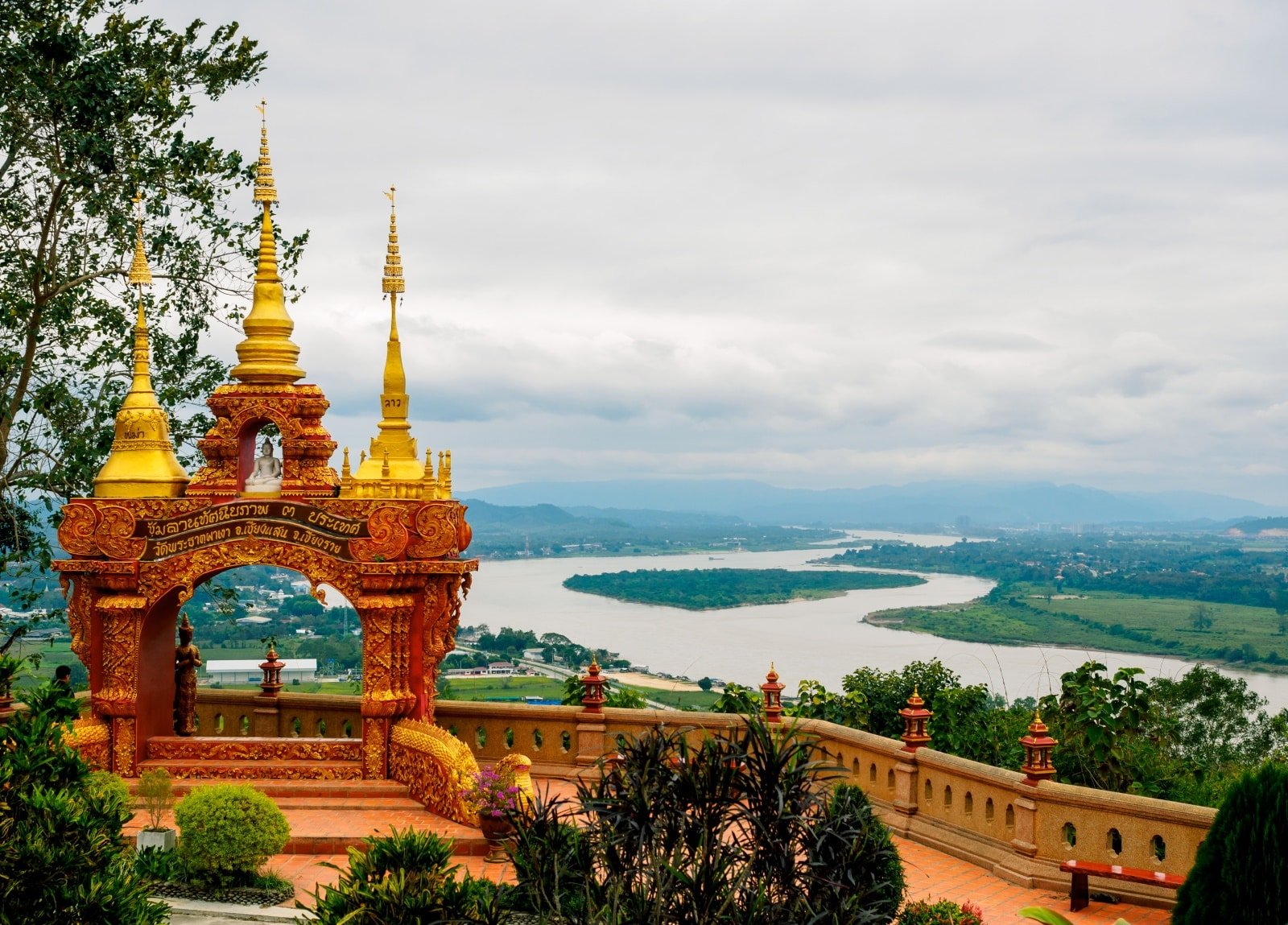
10. The Golden Triangle
The Golden Triangle, where the borders of Thailand, Laos, and Myanmar converge, offers a unique cultural and geographical experience. This area, once notorious for its opium production, now provides insights into the region’s history with attractions like the Hall of Opium Museum.
A boat ride on the Mekong River is a serene way to experience the beauty of this area and the confluence of the three countries. The ancient city of Chiang Saen nearby, with its ruins and temples, adds a historical dimension to your visit. The Golden Triangle’s cultural influences and stunning landscapes make it a fascinating destination in Northern Thailand.
Insider’s Tip: For a panoramic view of the three countries, visit the viewpoint at Wat Phra That Pu Khao.
How To Get There: The Golden Triangle is accessible by bus or car from Chiang Rai.
Best Time To Travel: The cool season, from November to February, offers comfortable weather for exploring.
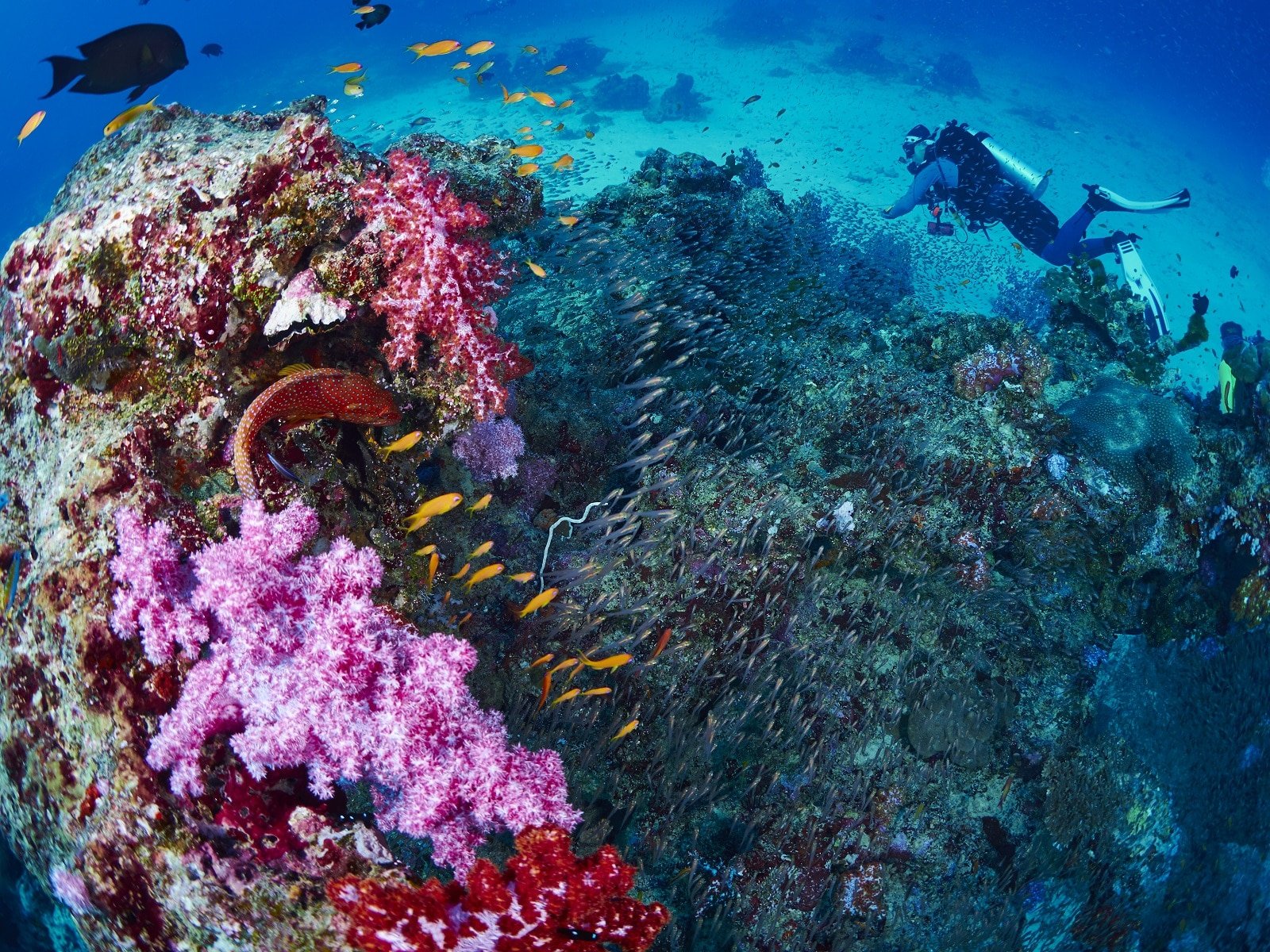
11. Similan Islands
The Similan Islands in the Andaman Sea are a pristine archipelago renowned for their exceptional diving and snorkeling opportunities. These islands, part of a protected national park, boast some of the clearest waters in Thailand, with visibility often extending up to 30 meters.
The underwater landscape of coral reefs teeming with diverse marine life, including manta rays, whale sharks, and a myriad of colorful fish species. Above water, the islands are equally stunning, with powdery white sand beaches and lush tropical forests. The Similan Islands are perfect for a retreat for anyone seeking unspoiled natural beauty.
Whether you’re exploring the depths of the ocean or simply relaxing on a secluded beach, the Similans offer a tranquil escape from the world, where nature’s wonders are on full display.
Insider’s Tip: Book a liveaboard diving trip for an immersive experience in the islands’ underwater world.
How To Get There: The Similan Islands are accessible by boat from Khao Lak or Phuket.
Best Time To Travel: The diving season runs from November to April, with the best conditions from February to April.

12. The Isaan Region
The Isaan region, located in northeastern Thailand, is a land steeped in tradition and history, offering a stark contrast to the country’s more tourist-centric areas. This region is the heartland of Thai culture, where ancient customs and lifestyles are preserved. Isaan’s rural landscapes, dotted with rice paddies and traditional villages, provide a glimpse into a simpler way of life.
The region is also home to some of Thailand’s most significant archaeological sites, including the prehistoric Ban Chiang and the Khmer ruins of Phanom Rung. Isaan’s cuisine, known for its bold flavors and spiciness, is a highlight, with dishes like som tam (spicy papaya salad) and larb (minced meat salad) being local staples
A journey through Isaan is a journey through the soul of Thailand, where the richness of the country’s heritage and the warmth of its people are palpable in every experience.
Insider’s Tip: Try the local dishes like som tam (spicy papaya salad) and larb (minced meat salad) for an authentic taste of Isaan.
How To Get There: Isaan is accessible by bus or train from Bangkok, or by plane to regional airports like Udon Thani.
Best Time To Travel: Visit during the cool season, from November to February, for comfortable travel conditions.
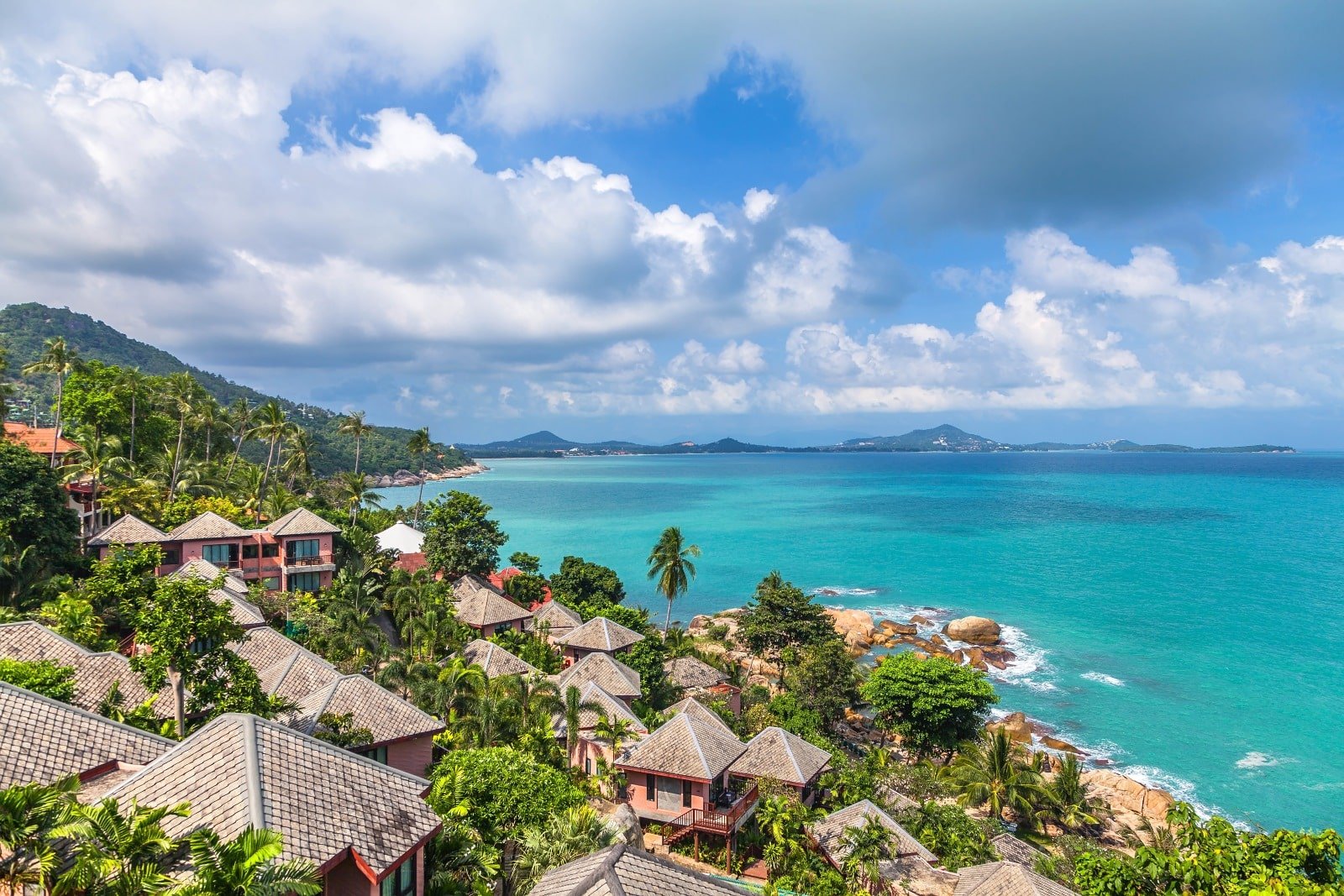
13. Koh Samui
Koh Samui, nestled in the Gulf of Thailand, is a tropical paradise combining natural beauty, luxury, and relaxation. The island is renowned for its idyllic beaches, such as Chaweng and Lamai, which offer crystal-clear waters and powdery white sands. Beyond its stunning coastline, Koh Samui has various attractions, from the majestic Big Buddha statue to the enchanting Na Muang Waterfalls.
The island’s interior is a lush landscape of coconut groves and rainforests, offering opportunities for hiking and exploring. Koh Samui’s culinary scene is a blend of traditional Thai flavors and international cuisine, with a plethora of dining options ranging from beachside shacks to upscale restaurants.
The island’s vibrant nightlife, centered around Chaweng Beach, provides entertainment well into the early hours. Koh Samui caters to all types of travelers seeking a romantic getaway, a family vacation, or a luxurious retreat.
Insider’s Tip: Explore the Ang Thong National Marine Park for stunning landscapes and snorkeling opportunities.
How To Get There: Koh Samui has an airport with flights from Bangkok, Chiang Mai, and international destinations.
Best Time To Travel: The best time to visit is from December to February, with dry weather and calm seas.
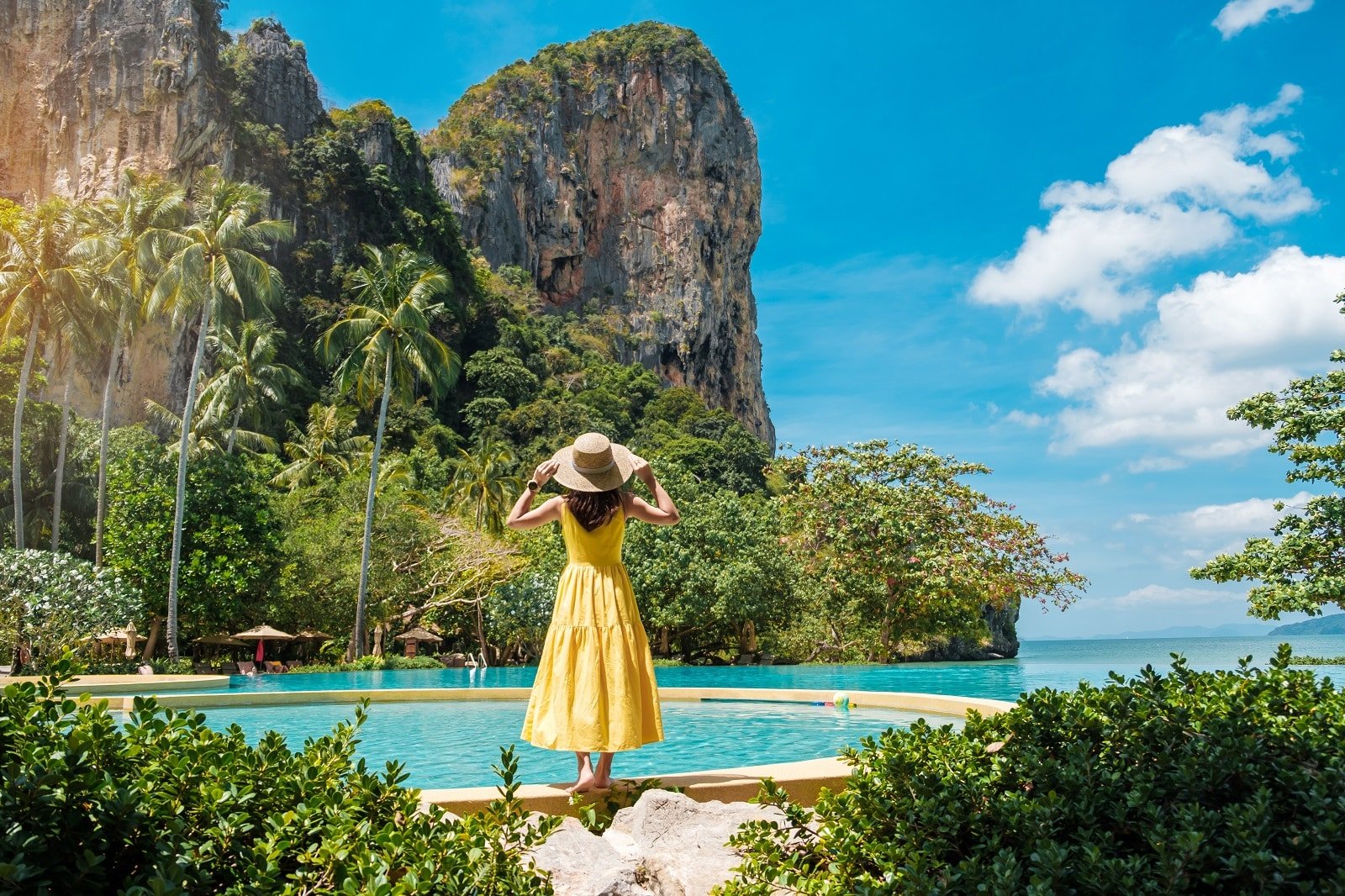
14. Railay Beach
Railay Beach, accessible only by boat, is a hidden gem offering a serene escape from the more crowded tourist spots. This peninsula, known for its stunning limestone cliffs and pristine beaches, is a haven for rock climbers and beachgoers.
The turquoise waters are perfect for swimming and kayaking, while the viewpoints and caves provide opportunities for exploration. Railay maintains a laid-back atmosphere, with a small selection of bars and restaurants, making it an ideal spot for adventure and relaxation in a tranquil setting.
Insider’s Tip: Take a rock climbing course if you’re a beginner to safely enjoy the sport under expert guidance.
How To Get There: Railay Beach is accessible by boat from Ao Nang or Krabi Town.
Best Time To Travel: Visit from November to April when the weather is dry, and the seas are calm.
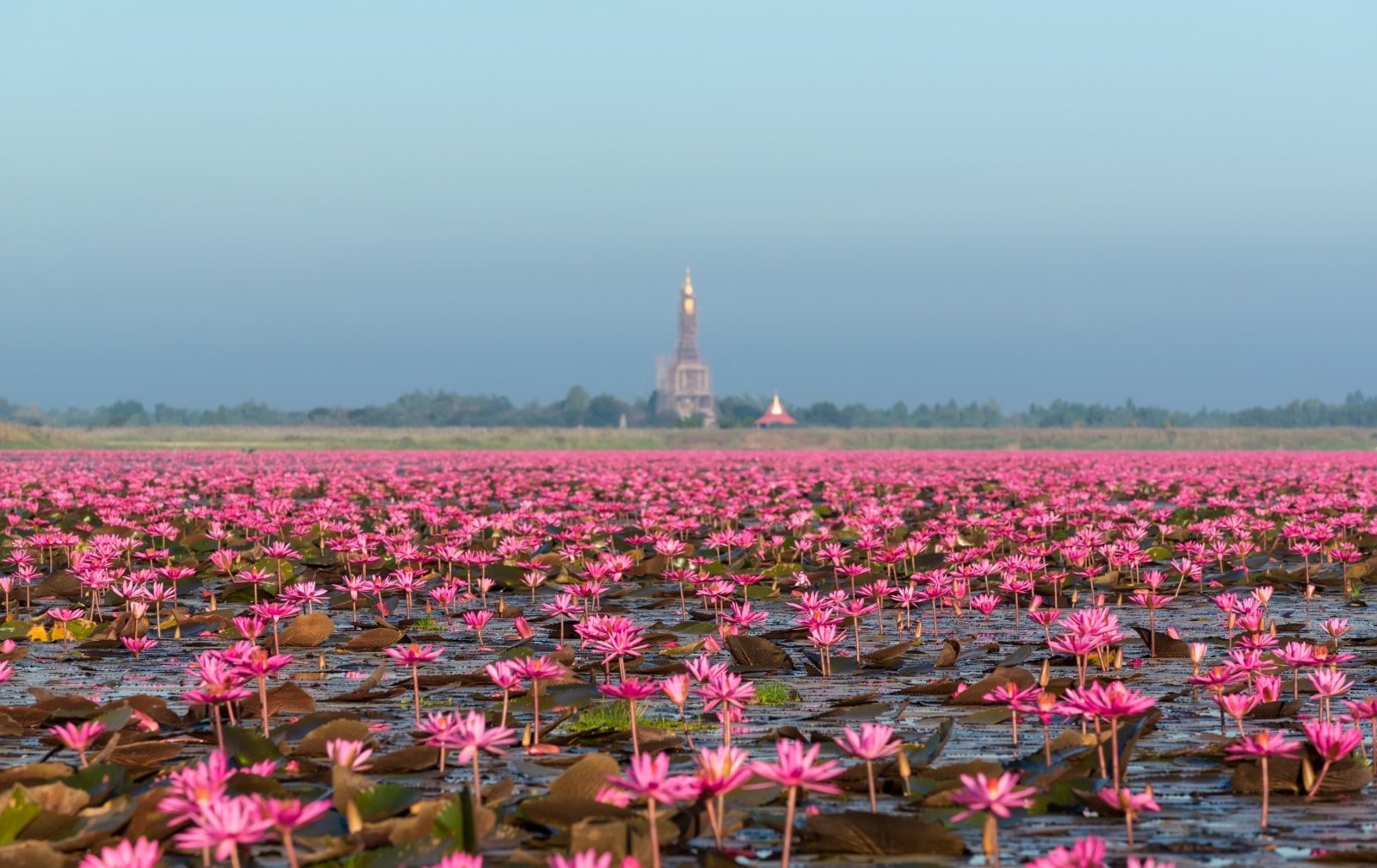

15. Udon Thani and the Red Lotus Sea
Udon Thani, a vibrant city in Thailand’s northeastern region, is the gateway to the mesmerizing Red Lotus Sea (Lake Nong Han). It’s best visited in the cool season, as it transforms into a breathtaking expanse of pink and red lotuses stretching as far as the eye can see. A boat ride through the serene waters, dotted with these vibrant blooms, offers a truly unique and tranquil experience.
Beyond the lake, Udon Thani boasts a rich cultural heritage, with various temples, museums, and markets reflecting the local Isan culture. The Ban Chiang Archaeological Site, a UNESCO World Heritage Site near Udon Thani, provides fascinating insights into the region’s ancient history.
This area’s blend of natural beauty and cultural depth makes it a compelling destination for those exploring beyond Thailand’s typical tourist paths.
Insider’s Tip: Visit early in the morning when the lotuses are fully bloomed and the lake is less crowded.
How To Get There: Udon Thani is accessible by plane from Bangkok, and the Red Lotus Sea is a short drive from the city.
Best Time To Travel: The lotuses bloom from December to February, making it the ideal time to visit.
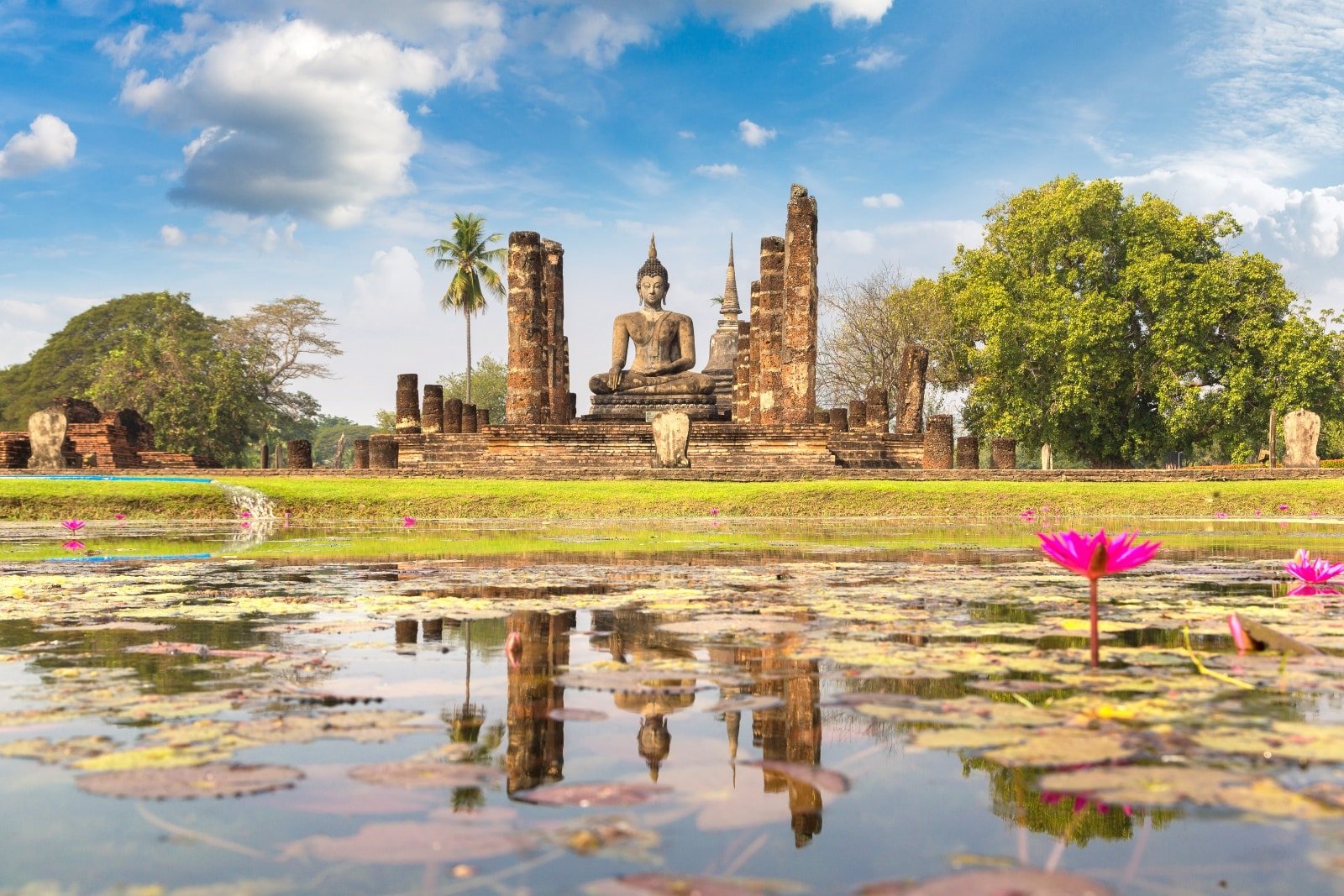
16. The Ancient City of Sukhothai
The ancient city of Sukhothai, a UNESCO World Heritage Site, is a journey back in time to the roots of Thai civilization. As the first capital of Thailand, it holds a special place in the nation’s history. The Sukhothai Historical Park, with its well-preserved ruins set amidst lush greenery and tranquil ponds, offers a glimpse into the grandeur of the 13th-century Sukhothai Kingdom.
Exploring the park, you’ll encounter majestic Buddha figures, towering stupas, and intricate carvings, all evocative of the city’s past splendor. Cycling through the park’s vast grounds allows for an intimate exploration of its numerous sites, including Wat Mahathat, the park’s largest temple, and Wat Si Chum, famous for its gigantic seated Buddha. A visit to Sukhothai immerses ancient Thailand’s artistic and spiritual legacy.
Insider’s Tip: Rent a bicycle to explore the extensive grounds of the historical park at your own pace.
How To Get There: Sukhothai is accessible by bus or plane from Bangkok, and the historical park is a short ride from the city center.
Best Time To Travel: The cool season from November to February offers pleasant weather for exploring the outdoor ruins.
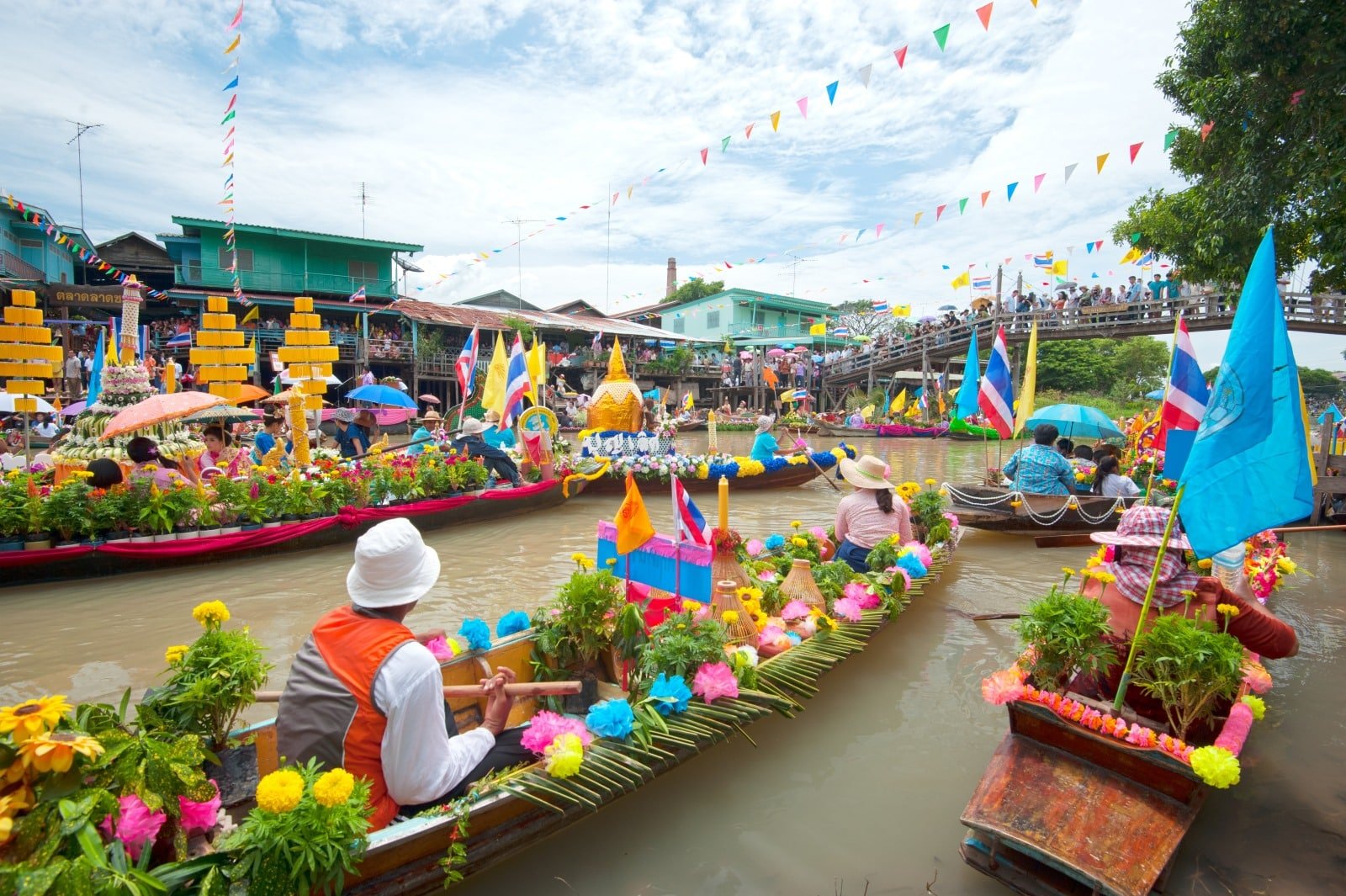
17. The Floating Markets Near Bangkok
The floating markets near Bangkok, such as Damnoen Saduak and Amphawa, offer a vibrant and colorful glimpse into traditional Thai life. These bustling waterways, lined with boats laden with fresh produce, local delicacies, and handicrafts, present a lively and picturesque scene.
A visit to these markets is a sensory experience, with the sights, sounds, and smells of authentic Thai commerce and cuisine. Damnoen Saduak, the most famous of these markets, provides a more tourist-focused experience, while Amphawa offers a more local atmosphere and is primarily known for its evening seafood vendors.
Exploring these floating markets by boat or along the canalside walkways is a unique way to experience the local culture and indulge in some of Thailand’s most delicious foods and charming souvenirs.
Insider’s Tip: Take a boat tour to fully experience the market and try local snacks from the floating vendors.
How To Get There: The floating markets are accessible by bus or organized tours from Bangkok.
Best Time To Travel: Visit early in the morning to avoid the crowds and the heat.
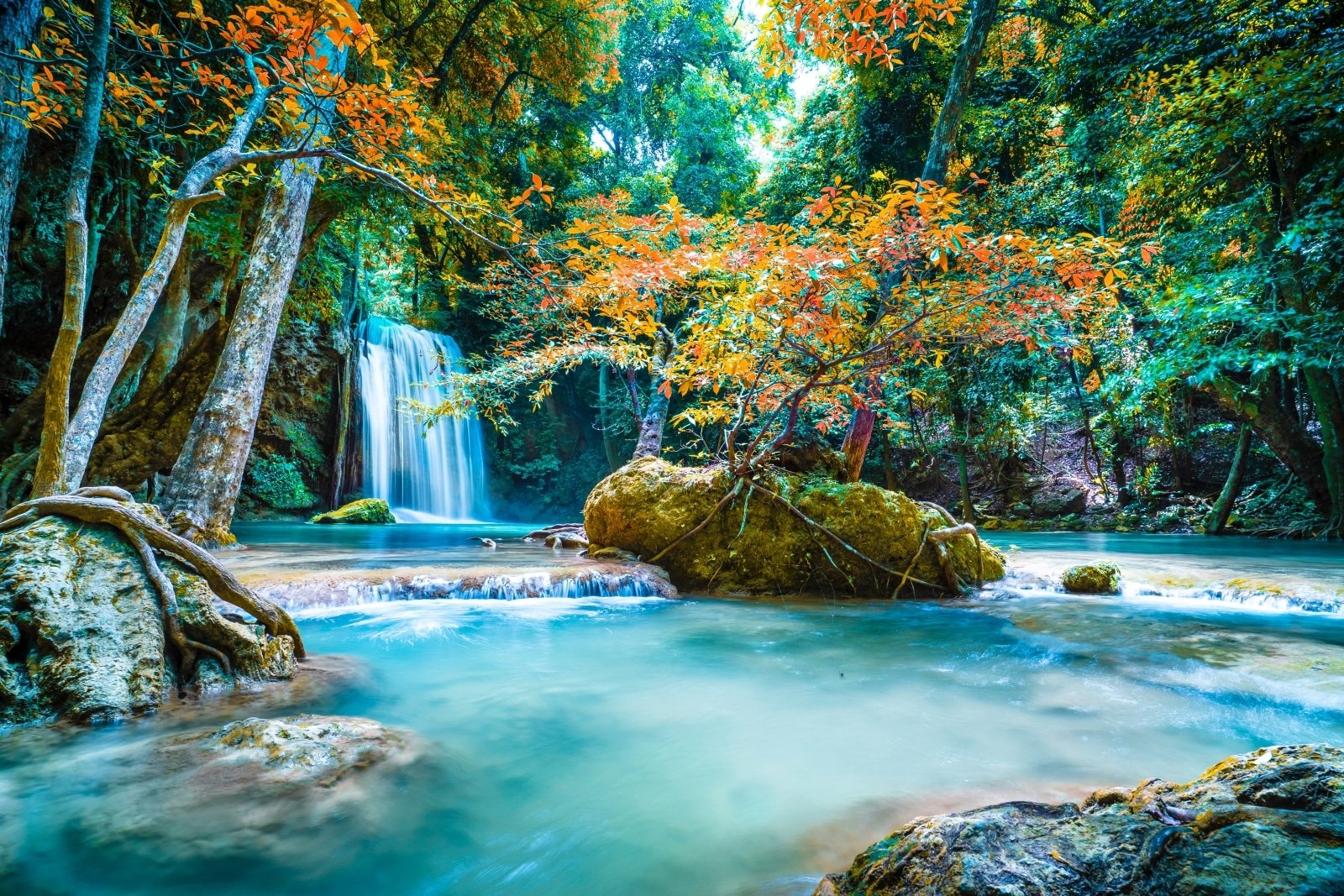
18. Erawan National Park and Waterfalls
Erawan National Park, located in the Kanchanaburi Province, is a natural oasis known for its stunning seven-tiered Erawan Waterfall, named after the three-headed elephant of Hindu mythology. Each tier of the waterfall offers a different shape and character, with natural pools perfect for swimming and relaxation.
The park’s lush forests are home to plentiful wildlife and provide numerous hiking trails for nature enthusiasts. Beyond the waterfalls, the park’s caves, such as Tham Phra That and Tham Ta Duang, offer further exploration opportunities.
Visiting Erawan National Park is a chance to witness one of Thailand’s most beautiful waterfalls and connect with the country’s rich natural landscapes.
Insider’s Tip: Bring swimwear and trek to the upper tiers of the waterfall for a more secluded and serene experience.
How To Get There: The park is located in Kanchanaburi Province and is accessible by bus or car from Bangkok.
Best Time To Travel: Visit from November to April when the water levels are ideal for swimming and the trails are dry.
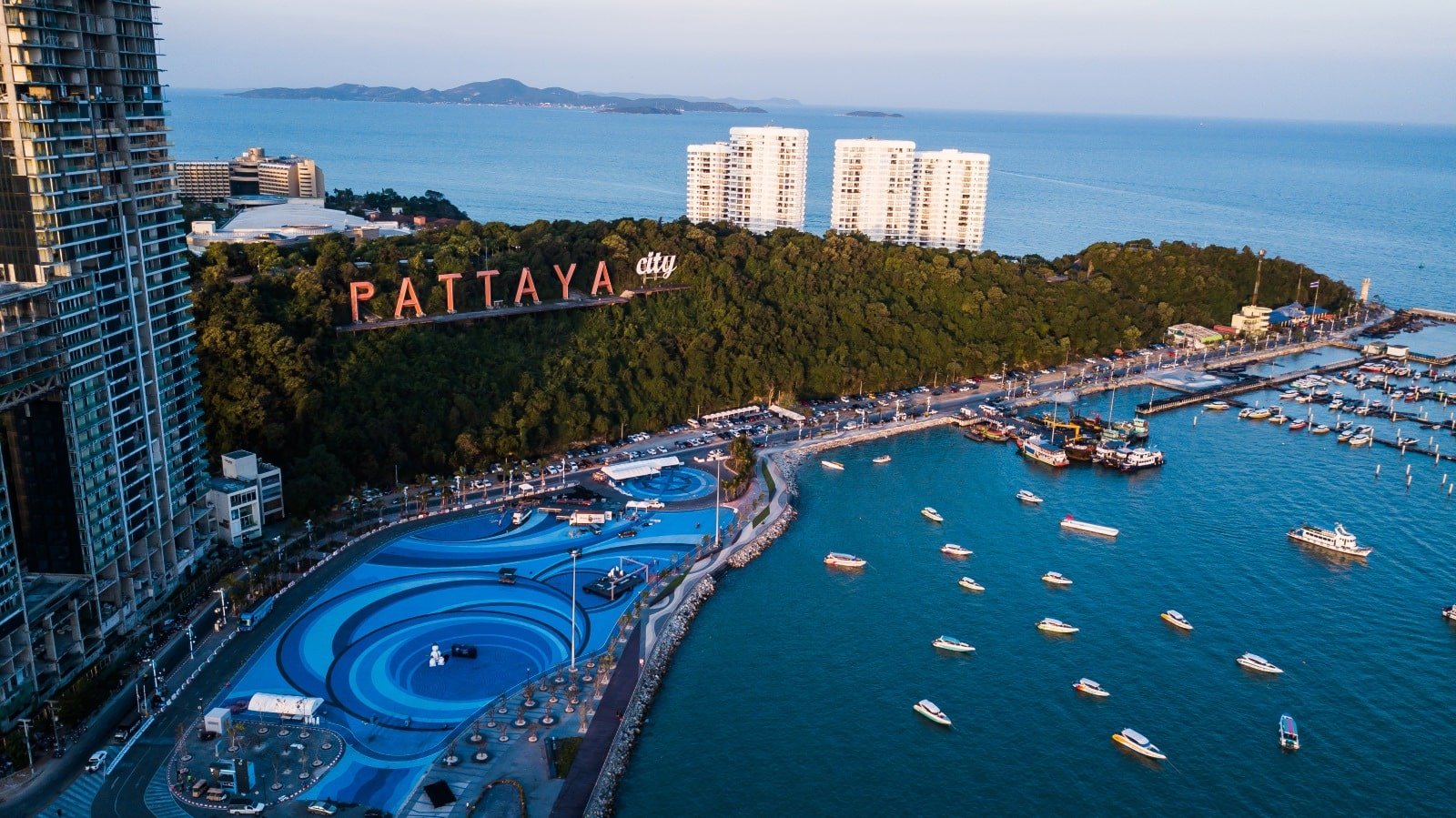
19. Pattaya
Pattaya, once a quiet fishing village and now a bustling coastal city, is known for its vibrant nightlife, sandy beaches, and many tourist attractions. While Pattaya’s reputation is often tied to its entertainment and nightlife, the city offers much more. The Sanctuary of Truth, a stunning all-wood structure filled with intricate carvings, highlights traditional Thai craftsmanship.
For nature lovers, Pattaya offers the Nong Nooch Tropical Botanical Garden, a beautifully landscaped park with themed gardens and cultural shows. The nearby Coral Island (Koh Larn) provides a quick escape to quieter beaches and clear waters, ideal for snorkeling and water sports. Pattaya’s diverse offerings make it a destination that caters to various interests, from cultural exploration to beachside relaxation.
Insider’s Tip: Explore the Pattaya Floating Market for a cultural experience and to sample local Thai dishes.
How To Get There: Pattaya is a two-hour drive from Bangkok and is also accessible by bus or taxi.
Best Time To Travel: Visit from November to February for pleasant weather and to avoid the rainy season.
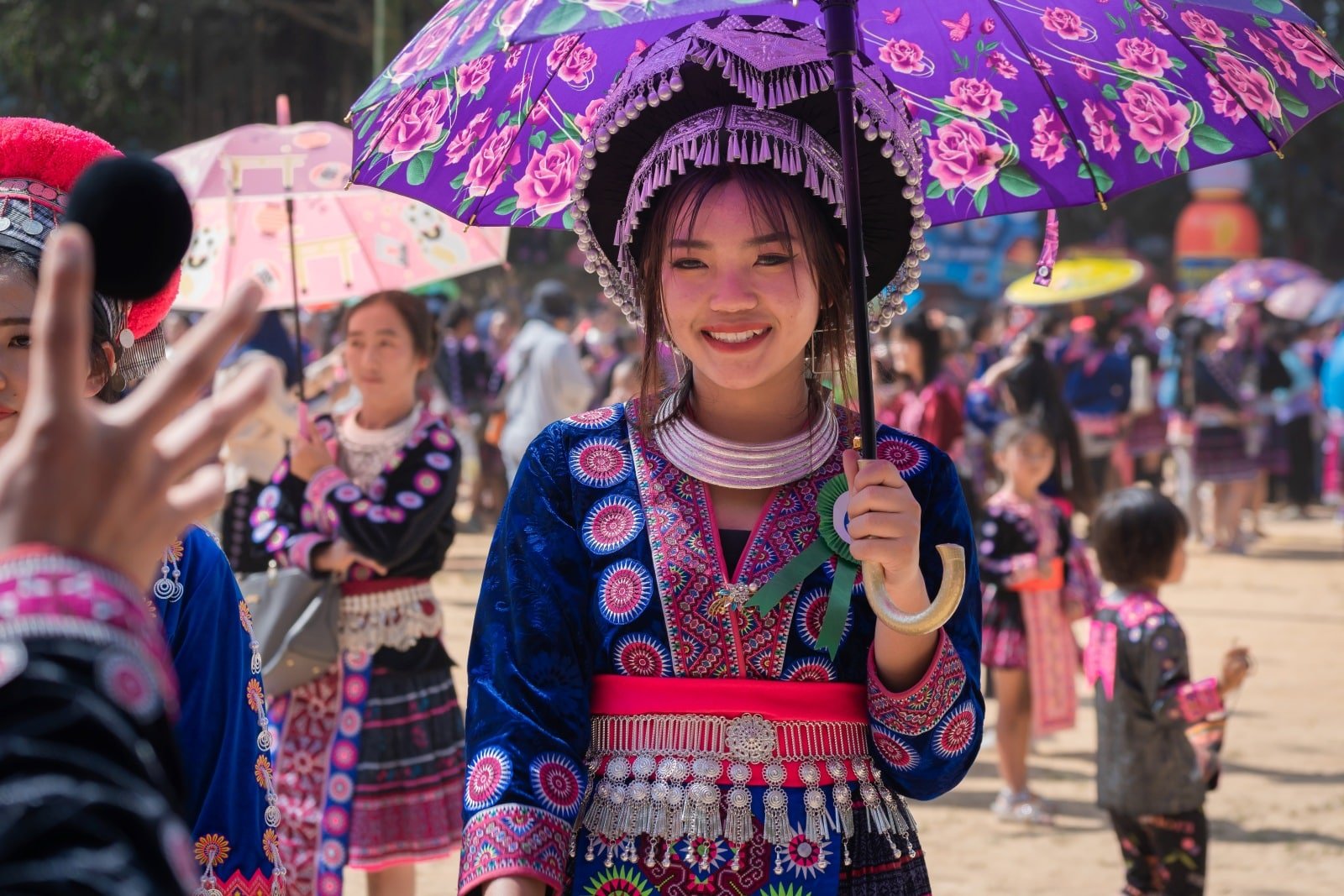
20. The Hill Tribes of Northern Thailand
Northern Thailand’s hill tribes offer a unique cultural experience, distinct from the rest of the country. These ethnic groups, including the Karen, Hmong, Akha, and Lisu, each have their own customs, languages, and traditional dress. Visiting these hill tribe villages, often nestled in the picturesque mountains and valleys of the region, provides insight into their traditional ways of life, which remain largely untouched by modernization.
Responsible and respectful tourism is key when visiting these communities. Many villages welcome visitors to learn about their culture, participate in traditional crafts, and even stay overnight for a more immersive experience. Engaging with the hill tribes of Northern Thailand offers a deeper understanding of the country’s ethnic diversity and rich cultural tapestry.
Insider’s Tip: Choose a community-based tourism program that benefits the tribes directly and respects their culture.
How To Get There: Hill tribe villages are accessible from Chiang Mai or Chiang Rai, often as part of guided tours.
Best Time To Travel: The cool season, from November to February, is comfortable for visiting the highland areas.
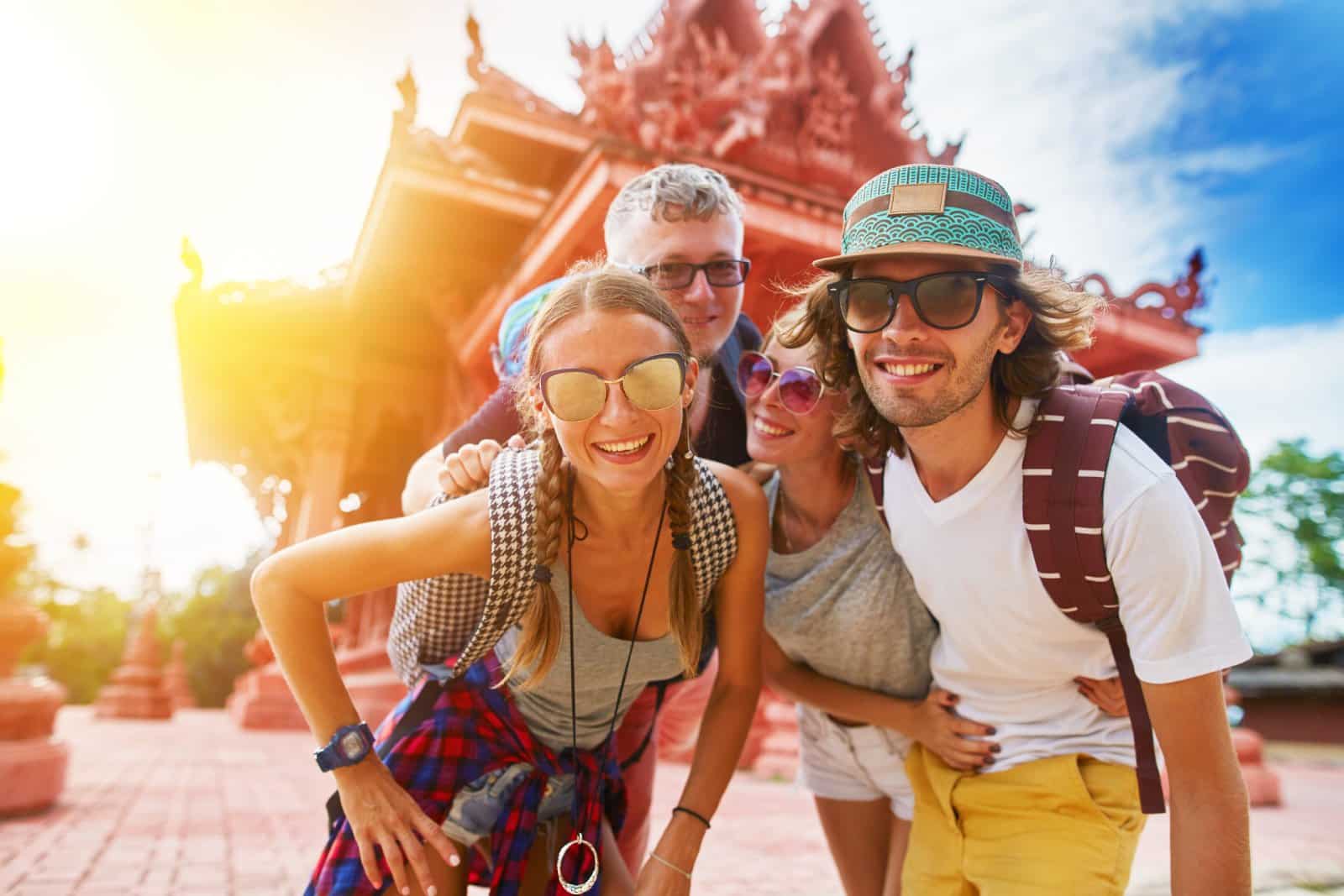
The Bottom Line
Thailand’s magic lies in its diversity – from bustling cities and ancient ruins to serene beaches and lush jungles. As you explore this enchanting country, embrace its history, indulge in its culinary delights, and immerse yourself in its natural beauty. Remember, Thailand offers an experience beyond the ordinary, leaving you with memories that will last a lifetime.
While exploring Thailand, take the time to learn a few phrases in Thai. A simple “hello” (sawasdee) or “thank you” (khob khun) can go a long way in showing respect for the local culture and enhancing your travel experience.
More Articles Like This…
Barcelona: Discover the Top 10 Beach Clubs
2024 Global City Travel Guide – Your Passport to the World’s Top Destination Cities
Exploring Khao Yai 2024 – A Hidden Gem of Thailand
The post Discover Thailand: Your Ultimate Guide to 20 Incredible Destinations in 2024 republished on Passing Thru with permission from The Green Voyage .
Featured Image Credit: Shutterstock / Pikoso.kz.
For transparency, this content was partly developed with AI assistance and carefully curated by an experienced editor to be informative and ensure accuracy.
More for You
The most popular TV host of all time isn't Johnny Carson or Dick Clark, according to fans. See the top 28.
Donald Trump's Team Makes 'Apparent Slip' in Court
19 Things People Treat As Safe That Actually Are Pretty Dangerous
Scientists sound alarm as growing threat looms over coastal states: 'We are preparing for the wrong disaster'
This is the salary it takes to be considered rich in every state
Chevron CEO reveals when US will see the 'end of the oil age'
The 11 Smells That Squirrels and Chipmunks Hate
Your senses will shut down in a specific order when you’re about to die
'Jeopardy! Masters' Fans Are in Awe After James Holzhauer Broke a Show Record on Season 2
Eamonn Walker Exits ‘Chicago Fire' As Series Regular After 12 Seasons
If you use any of these 4 phrases you have higher emotional intelligence than most
15 Jobs That Pay Insanely Well
The 11 Rudest Things You Can Do In Someone Else’s House, According To Etiquette Experts
Doctor shares what happens to our bodies moments before we die
25 iconic actors at the start of their career vs. now
This American Engine Produces The Most Horsepower Per Liter
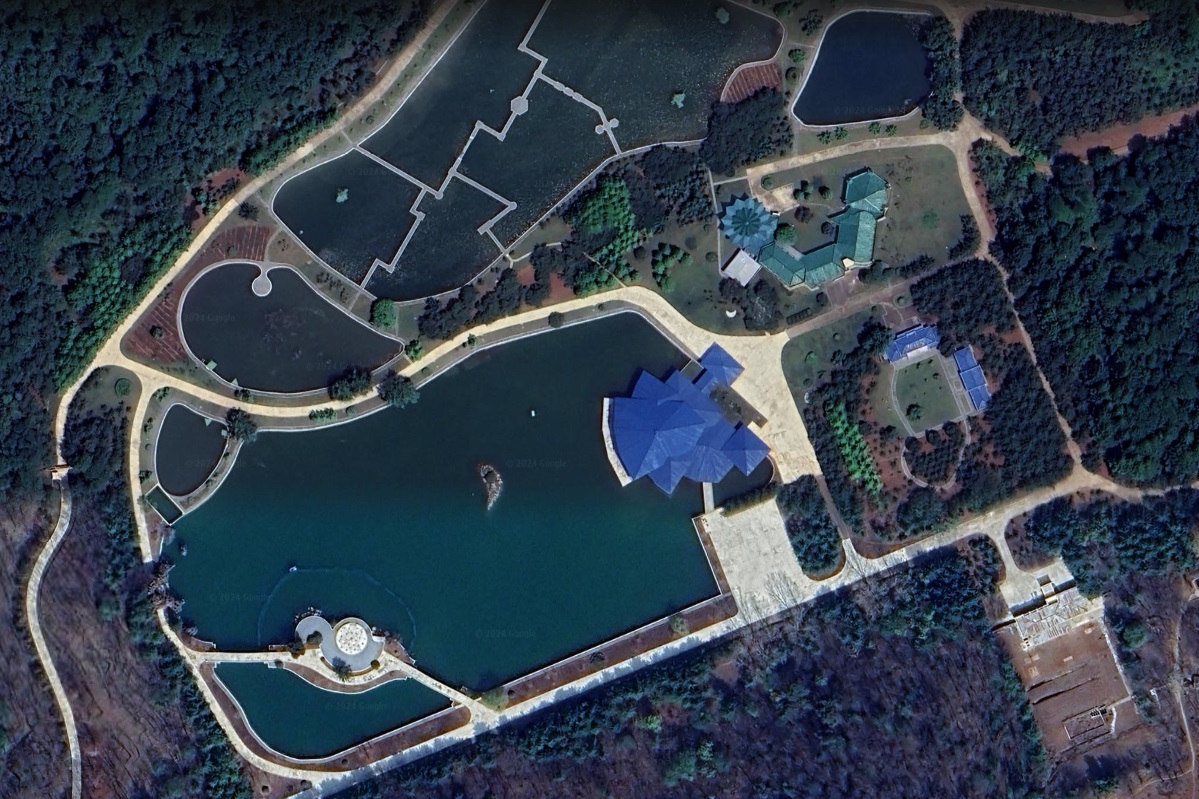
Kim Jong Un Demolishes Own Palace, North Korea Watchers Say
Here’s What the US Minimum Wage Was the Year You Were Born
17 Phrases Confident People Use to Stand Up For Themselves
US responds to Putin's nuclear threats and gives dictator advice
Academia.edu no longer supports Internet Explorer.
To browse Academia.edu and the wider internet faster and more securely, please take a few seconds to upgrade your browser .
Enter the email address you signed up with and we'll email you a reset link.
- We're Hiring!
- Help Center

Creative Tourism through food activities in Thailand

2018, International Journal of Management and Economics
Related Papers
nonthawan s , Jutamas Wisansing
International Journal of Science and Research (IJSR)
sunita mishra
The present study was conducted at Lucknow District in Uttar Pradesh. The purpose of this study is to document how being in different of creative activities can influence development in academics, physical development, and cognitive skill. 100 students of age group between 9 to 12 years comprised the sample of the study. Self made questionnaire for school students were administered. Data was analyzed in term of mean and t-test analysis. The statistical analysis revealed that all the types of creative activities, Football, cricket, Badminton, Dance and Music, activities together showed significant role in impact of creativity activities on students in Government school and Private School. Students who participate in creativity activities generally benefit from the many opportunities afforded them. Benefits of participating in creativity activities included having better grades, having higher standardized test scores and attending school more regularly, and having higher a higher self...
Tourism and hospitality management
Karmen Mikulić
greg richards
Presentation at the World Travel Market Conference on ‘Creative Tourism: All that you need to know about this growing sector’, November 3rd 2015. Creative tourism is a relatively new niche that is being taken up by destinations around the world. The basic reason for this is the growing dissatisfaction with traditional models of tourism development, and the realisation that the creativity of both hosts and tourists is an important potential resource for the sustainable development of tourism. This brief presentation reviews the important features of creative tourism and how it is changing people’s lives.
sudirah sudirah
In the development of tourism analysis, the potential of creative tourism is an interesting study. The essence of tourism development among others is the development that emphasizes local wisdom, and preservation of Cultural arts (batik). Development of batik creative tourism potential, it is appropriate to consider supporting aspects of tourism, and the characteristics of creative tourism. Batik Creative Tourism offers tourists the opportunity to develop creativity by learning with the locals in the process of making batik. The study from this economic sociological perspective is backed by the powerlessness of the tourism sector in developing the creative tourism potential of batik. Creative tourism requires the development of potential for the advancement of Batik creative tourism. This article examines the development of the creative tourism potential of batik in the village of Terusan and Paoman, district of Indramayu, West Java, in 2018. Data is obtained through observation, do...
In Asia the creative tourism concept has developed in a number of interesting directions in recent years. Creative tourism has been embraced by the members of ASEAN as a whole (ref), but the different countries in the region have developed different approaches to developing links between tourism and creativity. In general, a division can be identified between fairly top-down approaches to creative tourism development (for example in China and South Korea) and bottom-up approaches that seek to involve local communities (Thailand and Indonesia). This paper briefly reviews some of these different approaches and discusses their effects and sustainability. Reference: Richards, G. (2017) The development of Creative Tourism in Asia. In Christopher Silver, Lenia Marques, Himasari Hanan and Indah Widiastuti (eds), Proceedings of the International Conference of Arte-Polis - Imagining Experience: Creative Tourism and The Making of Place. Springer Science+Business Media New York ,pp. ix-xiv.
Journal of Geography in Higher Education
Aleksandra Mroczek-Żulicka
Milica Ilincic
In the last decade creative tourism emerged as a new form of cultural tourism emphasizing higher involvement and interaction of tourists with the culture of the destination. It is the field of tourism still scarcely researched, with most of the effort concentrated on the experience of creative producers. Thus, this study looked at the demand side and sought to explore beneficial experiences tourists attain through participation in creative tourism activities. It examined motivation as well as emotive and psychological processes experienced by tourists in their interaction with the activity setting in order to find how these experiences are valued or seen as beneficial. The study is performed on the case of creative cooking workshops organized by Espai Boisa company in Barcelona. A qualitative methodology based on face-to-face interviews and observations was deemed the most appropriate to attain the research aims. It is found that tourists see multiple benefits of their creative cooking experience. The key benefits noted are: cognitive – insight gain and cooking skill development; affective – possibility of future sharing of the experience; reflective – learning different approach to Spanish cuisine; and social benefits – spending time with others. While the tourists reporting social gains as most important showed little interest in the activity and are regarded as mindless, tourist pointing other benefits were sensitive to context and mindful. Moreover, through active participation and co-creation with locals, mindful tourists not only got to experience immersion and psychological engagement with the culture of the region, but they also perceived the experience as memorable and authentic. It is found that tourists can at the same time be mindful and, in a way, mindless. The study has important implications for marketing and management of creative tourism field and can help in the improvement of related tourist experiences.
Dr Yashpal D Netragaonkar
A study on "fostering activities and programmes for creativity" explore the ability of creativeness which every individual possess to some extent. It helps the student to think constructively which depends on different environment and conditions provided to the students to foster activities for creativity.In the said research, a study of defense Mechanism was conducted. Keywords –Activity,Creativity,Ability, Brainstorming,Gaming,Drumatics
Creative tourism has now been developing for almost 20 years since the first seeds were sown for this niche form of tourism in the late 1990s. This paper reviews the development of creative tourism over the past 20 years, and analyses the different forms of creative tourism in different parts of the world.
RELATED PAPERS
Journal of Interventional Cardiology
Ronald Krone
Revista Interdisciplinar de Gestão Social
silvia helena Passarelli
Annals of Surgery
Stuart Knechtle
Felipe Peretti
Gender Equality and Stereotyping in Secondary Schools
Viktória Mihalkó
Chungará (Arica)
Ivan Caceres
Dorit Kedar
Jean-Pierre Maillard
drifte.rc.unesp.br
Jose de Araujo Nogueira Neto
interstat.statjournals.net
Dr.G. Ayyappan Govindan
Ciencias Naturales Y Exactas Handbook T Ii Congreso Interdisciplinario De Cuerpos Academicos 2014 Isbn 978 607 8324 18 7 Pags 249 256
Miriam Pérez , Veronica Morales
Ümit YAPICI
Genel Tıp Dergisi
Mehtap Gürger
Jorge Rodrigues Silva
Advancing Culture of Living with Landslides
stefano lanzoni
Epilepsy - Histological, Electroencephalographic and Psychological Aspects
Spiros Konitsiotis
STRATEGY : Jurnal Inovasi Strategi dan Model Pembelajaran
bilal bilal
Marcela Crespo Buiturón
Chemical Communications
Yogesh Sanghvi
Monthly Notices of the Royal Astronomical Society
Md Rasel Hossen
Sveučilište u Zagrebu. Filozofski fakultet. Odsjek za etnologiju i kulturnu antropologiju.
Aleksandra Relić
Machiel Reinders
JETri Jurnal Ilmiah Teknik Elektro
Teknik Elektro A
Journal of Medical Case Reports
Sachith Mettananda
- We're Hiring!
- Help Center
- Find new research papers in:
- Health Sciences
- Earth Sciences
- Cognitive Science
- Mathematics
- Computer Science
- Academia ©2024

‘Dive’ into tourism at the festival of ‘Spotlight Koh Tao 2024’
Embrace the beauty of nature at Koh Tao’s highly anticipated annual event, Spotlight Koh Tao 2024. This remarkable festival is dedicated to honouring nature and community, making it a standout celebration.
The festival offers a diverse range of activities, including educating attendees about nature conservation, promoting green economy initiatives, showcasing the power of community, and emphasizing sustainable management practices. Our primary goal is to encourage responsible and sustainable tourism, and we invite you to join us from 3-5 May 2024 at Aow Leuk, Koh Tao.
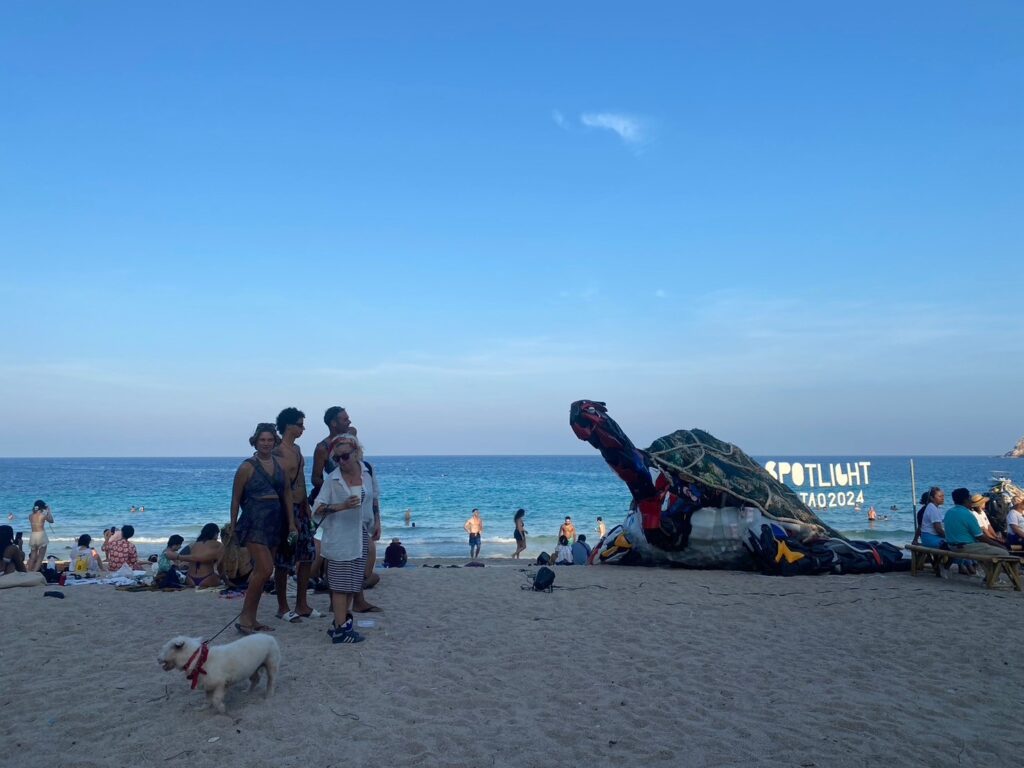
“Koh Tao stands out as one of the world’s most renowned diving destinations, attracting over 700,000 international visitors annually and generating an income of around 20,000,000,000 Baht.” Rumluek Assavachin, the president of Koh Tao Tourism Association has said that “Koh Tao’s diverse array of corals and marine life serves as a precious resource for us, particularly in the aftermath of the pandemic. It has significantly bolstered efforts in rehabilitation, prompting a newfound emphasis on environmentally conscious travel.”
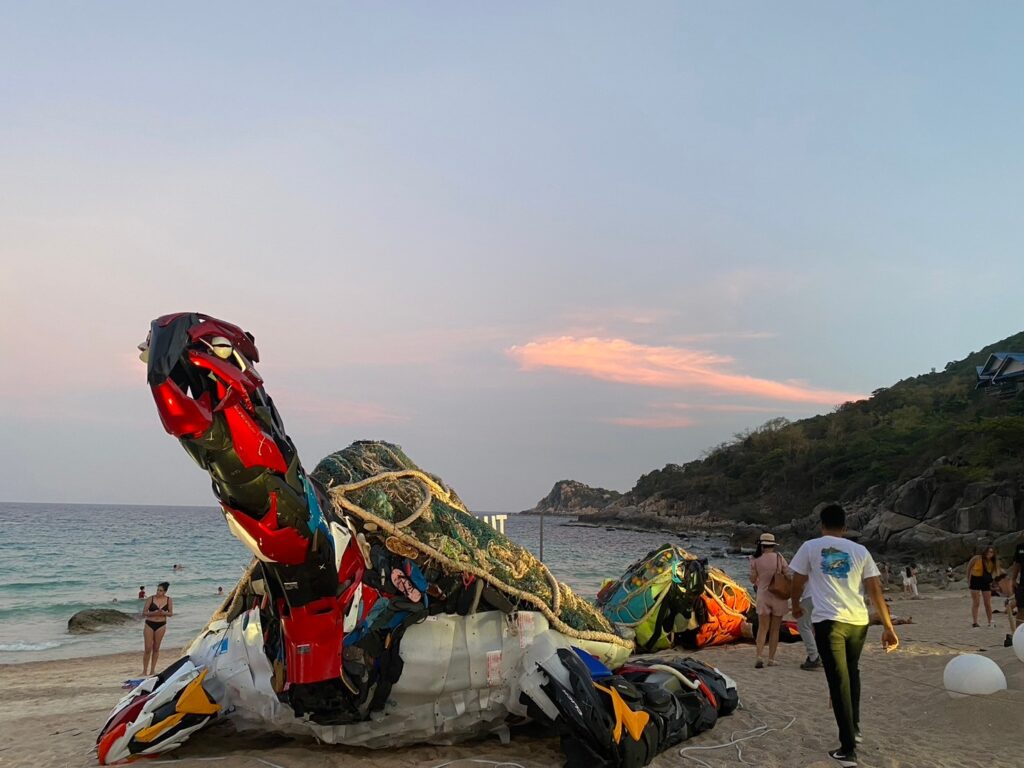
“This year, the Spotlight Koh Tao aims to invite all of you to embark on a new way of experiencing Koh Tao travel. Our vision is to establish this island as a captivating marine attraction, offering opportunities to learn about the underwater world while promoting social and environmental responsibility. Furthermore, we strive to elevate our reputation as a Sustainable Island Tourism Destination.”, said the president of Koh Tao Tourism Association.
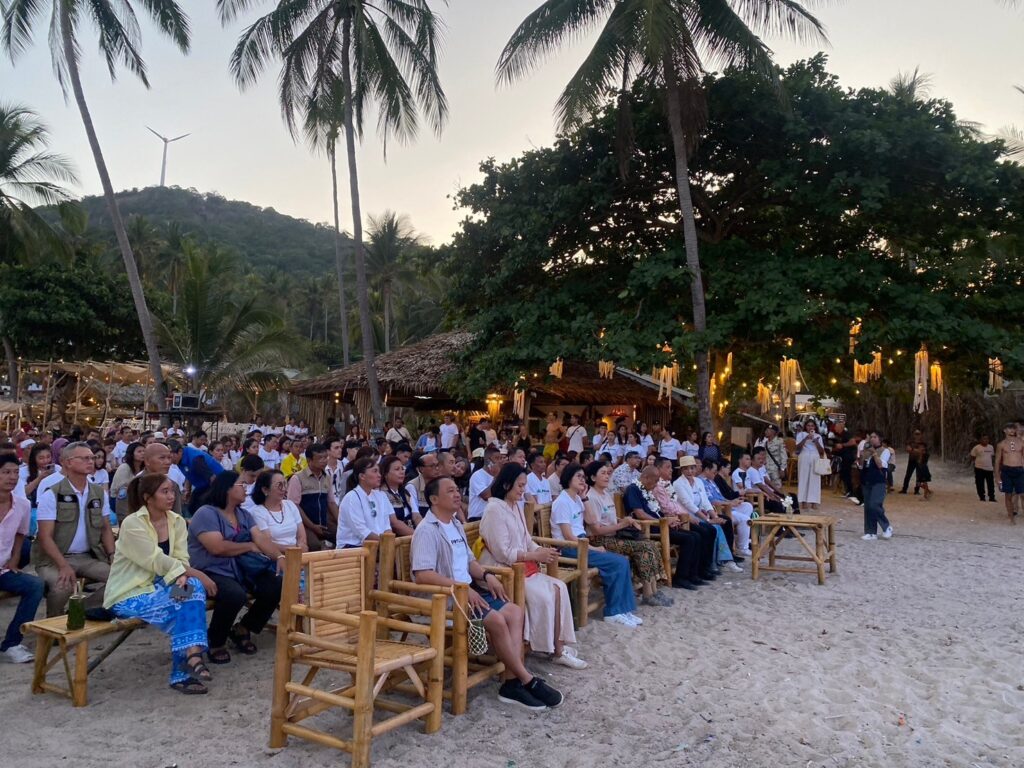
Visitors at the festival will have the opportunity to participate in 12 land and sea environmental conservation activities that showcase Koh Tao’s commitment to being a socially and environmentally responsible tourist destination.
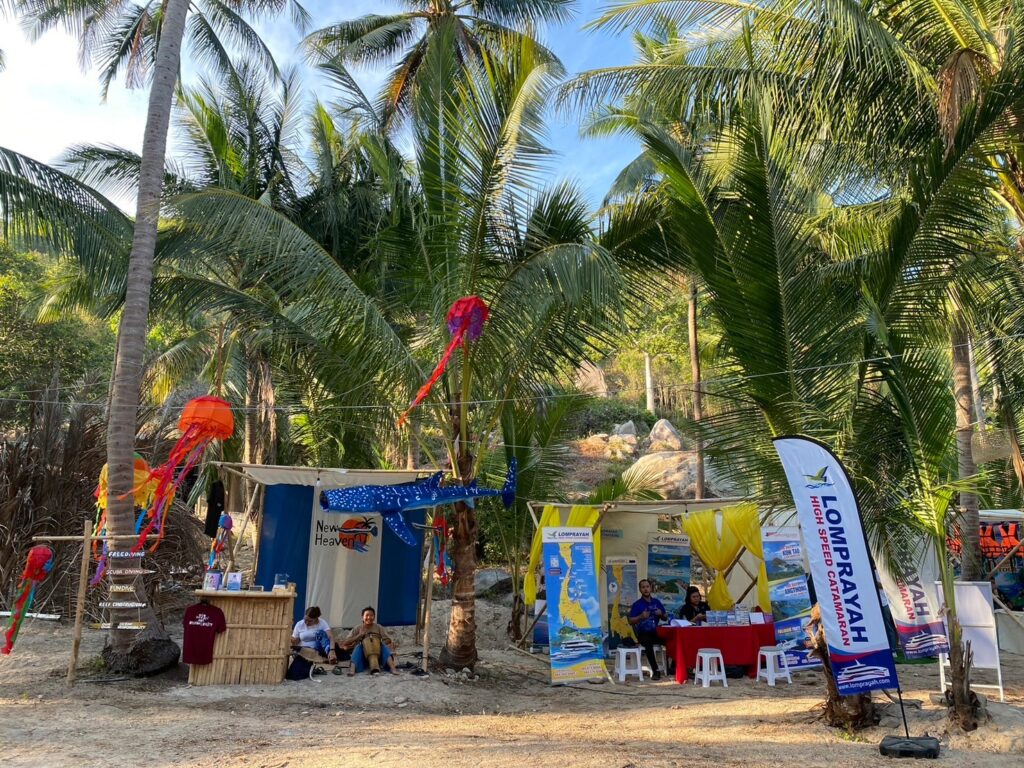
The activities compose of Growing for Saving, Zero Food Waste Thai Cuisine, CoCo Tie Dye, Sea Glass Jewelry, Eco Print Fabric, Plas-Tao, Zero Waste / Natural Products, Fish Aggregation with Local Fishermen, Coral Reef Rehabilitation, Reef Watch Monitoring, Mooring Line Maintenance, and Underwater Clean Up. Moreover, there will be wellness activities such as Ice Bathing, Sound Therapy, Yoga, and Thai Fire Massage.
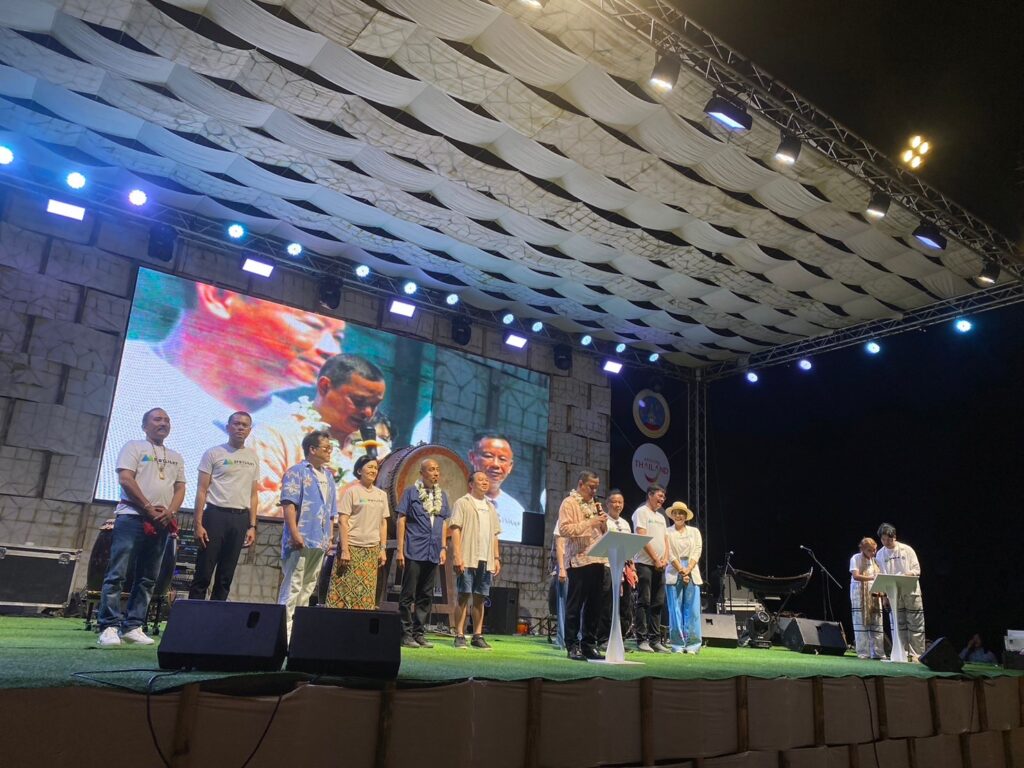
Guests can have a wonderful time at Koh Tao Photo Contest & Exhibition, and Koh Tao Green Market, recognized as the most sustainable market in the Gulf of Thailand. Visitors can shop for local products, and savor traditional dishes.
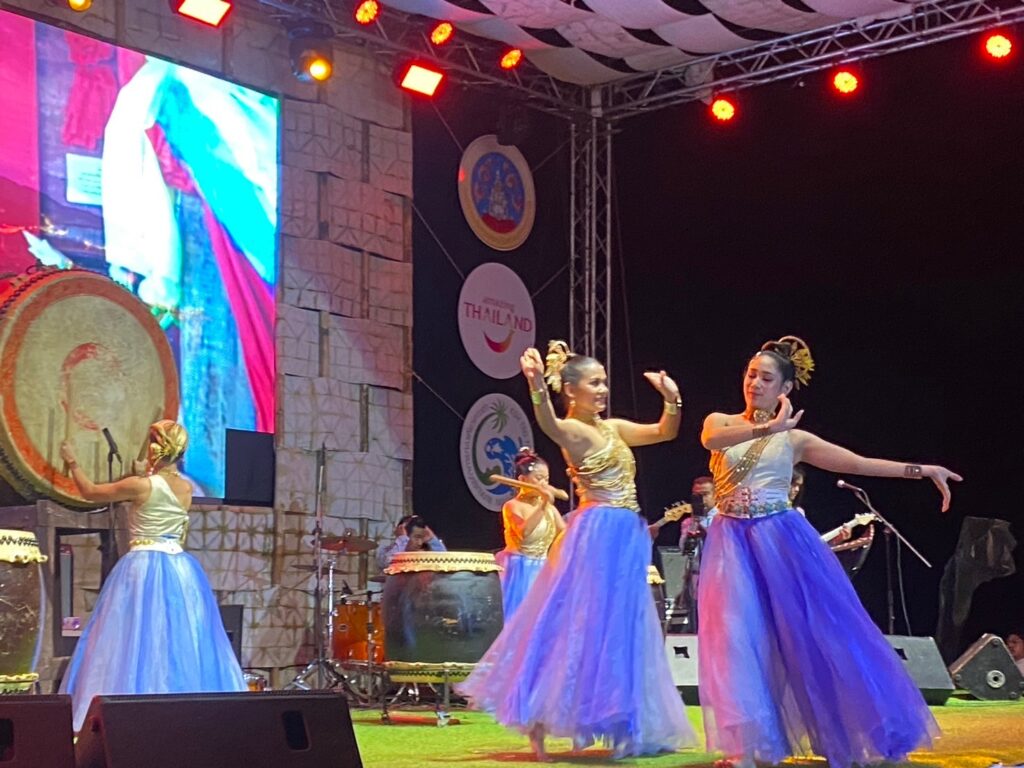
Furthermore, there will be a diverse range of performances to enjoy, including local and international sports competitions, Koh Tao history exhibition, along with the captivating Spotlight Runway Show featuring Mister Global and local islanders.
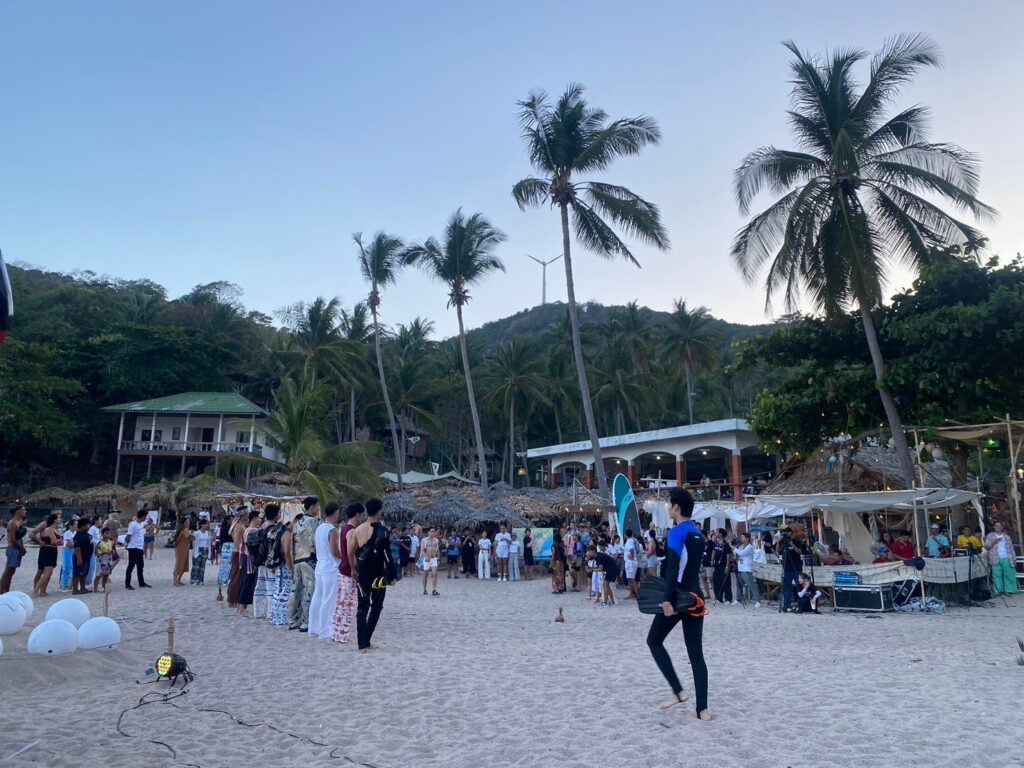
We look forward to your presence at the event, which has brought together the entire community with the purpose of showcasing our true essence and our vision for Koh Tao as an eco-friendly destination. Join us from May 3-5 at Aow Leuk, Koh Tao.
Since you're here...
...there are many ways you can work with us to advertise your company and connect to your customers. Our team can help you design and create an advertising campaign
We can also organize a real life or digital event for you and find thought leader speakers as well as industry leaders, who could be your potential partners, to join the event. We also run some awards programmes which give you an opportunity to be recognized for your achievements during the year and you can join this as a participant or a sponsor.
Let us help you drive your business forward with a good partnership!
Yes, contact me I want to download the media kit
Comments are closed.
LATEST STORIES

Amy Poehler to appear at Vivid Sydney 2024

Hyde Bodrum opens with 212 keys
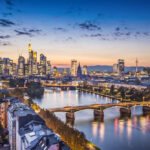
The Meetings Industry Association exhibits at IMEX for first time
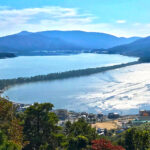
Walk Japan launches the KYOTO: MOUNTAINS TO THE SEA
Welcome, Login to your account.
Sign in with Google
Powered by wp-glogin.com
Recover your password.
A password will be e-mailed to you.
Welcome back, Log in to your account.
SIGN UP FOR FREE
Be part of our community of seasoned travel and hospitality industry professionals from all over the world.
- LOGIN / SIGN UP
- Middle East
- UK & Europe
- USA & Canada
- Hospitality
- HR & Careers
- Luxury Travel
- MICE (Meetings, Incentives, Conferencing, Exhibitions)
- Travel Tech
- Travel Agents
- Airlines / Airports
- Conferences
- Cruising (Ocean)
- Cruising (River)
- Destination Management (DMC)
- Hotels & Resorts
- Hotel Management Company
- Hotel Technology
- HR / Appointments
- Meetings, Incentives, Conferencing, Exhibitions (MICE)
- Travel Agents (all)
- Travel Technology
- Tourism Boards
- TDM Travel Show
- Industry appointments
- Travel Bloggers
- Podcasts – Features
- How to join
- RSVP Portal
- Event Photos/Videos
- Competitions
- Search for Jobs
- Destination NaJomtien BanAmphur BangSaray *NEW*
- จุดหมายปลายทาง นาจอมเทียน หาดบ้านอำเภอ บางเสร่ *NEW*
- South Australia Reward Wonders *NEW*
- Ponant Yacht Cruises and Expeditions
- Encore Tickets (Chinese Guide)
- Affordable Luxury in Thailand by Centara Hotels
- Rising Above the Oridinary by Conrad Bangkok
- The Best of Thailand
- Who is IWTA
- Philippines
- Recommend Someone
- Recommend yourself
- IWTA AWARDS
- TRAVEL CLUB

IMAGES
VIDEO
COMMENTS
Keywords: Cultural tourism, creative tourism, planning, Phuket Old Town. Introduction While creative tourism has been of interest in many parts of the world for almost two decades, it is not well understood within the Southeast Asian region amongst key stakeholders. The literature identifies that linking creative tourism to
A survey of the policies which have initiated and driven creative tourism in Thailand was conducted, followed by a quantitative survey which was carried out by distributing questionnaires to 300 Thai tourists in the target areas (each 150) along with in-depth interviews. The two target areas were chosen, namely, the ceramic manufacturing areas ...
This article contributes to an understanding of how creative tourism is perceived on a national level, by using Thailand as a case analysis. The primary objective of this article is to investigate Thailand's plans and policies for the creative economy at both national and ministry levels in relation to creative tourism.
According to CEA, the creative industries contributed 8.93 per cent to Thailand's GDP in 2018 (0.8 per cent less than in 2015 at 9.1 per cent of GDP and 3.07 per cent less than in 2009 at 12 per cent of GDP). This contribution is valued at 46.4 billion US dollars. Figure 2 indicates the economic contribution of specific industries.
established in 2018 to lead Thailand's creative economy agenda. This opportune context has sparked increased public and private investments in innovation and creativity agendas, with a recorded emphasis on creative districts and, more recently, creative hubs as catalysts for social and economic changes. Foreword from the British Council Contents
The creative tourism plays a role in generating economic income for more than 30 countries around the world with the aim to introduce creative tourism development policies such as France, Indonesia, South Africa, New Zealand, etc. (Tourism Marketing Strategy Division, 2016). For Thailand, the creative tourism is still new.
Thai Boxing. Thai Massages workshops. Photographic routes. Sketch tourism. Painting classes. Ceramic classes. Artscrafts and baskettry workshops. Provisional information, full details coming soon. Thailand Creative Tourism on the Medias:
For creative tourism in Thailand to succeed, the support of creative and cultural resources, including creative skills for tourism personnel, is necessary to satisfy the needs stimulated by such campaigns. This means that the tourism infrastructure for such a movement needs to be (a) executed as part of the policy and (b) ready to meet tourists ...
Thailand is chosen as an example of how government and related agencies can contribute to a national creative tourism movement in the country, especially in the light of the Tourism Authority of ...
Thailand has positioned itself as 'the first creative tourism destination in Asia' (Wattanacharoensil & Schuckert, 2016). In 2011, the Designated Areas for Sustainable Tourism Administration (DASTA), started creative tourism programmes (Songserm & Wisansing, 2014) providing experiences for tourists in rural villages. Appreciative inquiry ...
In Thailand, Creative Tourism supports regional development. The Thai government has developed a The Thai government has developed a creative economy approach which involves a significant tourism ...
This article utilizes Greg Richard and Crispin Raymond's (2000; 2010) creative tourism concept as a framework for understanding problems and obstacles of creative tourism practice in Thailand. This article reports the results of a survey of perception towards creative tourism by Thai tourists including problems and obstacles in the potential tourist areas that have been developed to be a ...
EXPERIENCE MANAGEMENT FOR CREATIVE COMMUNITY-BASED TOURISM IN THE CENTRAL REGION OF THAILAND AFTER THE COVID-19 PANDEMIC Nuchpravee Likitsarun, Kasetsart University Kamphaeng Saen Campus ... The central region of Thailand can convey traditional way of life that indicates an identity reflecting the roots of Thai people in the past. As a result ...
s The study of "A Guideline on Sustainable Management of Creative Tourism in Nakhon Si Thammarat Province, Thailand" is a mixed methodology research in which both qualitative and quantitative research methods were employed. The objectives the research were to study the circumstances in creative tourism destinations in Nakhon Si Thammarat Province, Thailand as well as to analyze the ...
The study of creative tourism in Thailand and abroad often involves cultural context because the concept of creative tourism uses the culture and history of the community to tell stories to tourists. Sofield, et al., (2017) studied the spatial design and place-making in 5 communities of Tasmania.
This article presents the development of Creative Tourism in Thailand as it is a new paradigm of tourism that contributes to sustainable tourism. The collaboration between DASTA and Thammasart University to pioneer Creative Tourism project has been carried out for 4 years and it is now the appropriate time to evaluate all 13 creative tourism ...
Dubai, 7 May 2024 - The Tourism Authority of Thailand (TAT) has launched the latest communication concept, "Amazing Thailand: Your Stories Never End," at the Arabian Travel Market (ATM), where the Thai pavilion presents a contingent of 64 Thai exhibitors at Dubai World Trade Center, United Arab Emirates, from 6-9 May 2024.. Ms. Thapanee Kiatphaibool, TAT Governor, said, "This is ...
7. Sukhothai. Sukhothai, the first capital of Thailand, is where Thai art, architecture, and language began to develop and flourish. The Sukhothai Historical Park, a UNESCO World Heritage Site, is ...
Creative Tourism in Thailand is just in the beginning stages. However, The Thai government has set up an agency that promotes creative tourism named Designed Areas for Sustainable Tourism Administration (DASTA); this will be helpful in bringing creative tourism strategies to national agenda in The National Economic and Social Development Plan ...
Our primary goal is to encourage responsible and sustainable tourism, and we invite you to join us from 3-5 May 2024 at Aow Leuk, Koh Tao. "Koh Tao stands out as one of the world's most ...